MARYLEBONE JOURNAL
ISSUE NO.101
BROUGHT TO YOU BY THE HOWARD DE WALDEN ESTATE AND THE PORTMAN ESTATE
P.14
ARTIST GLENN BROWN ON APPROPRIATION, CREATIVE STRUGGLE, AND OPENING HIS DOORS TO THE PUBLIC
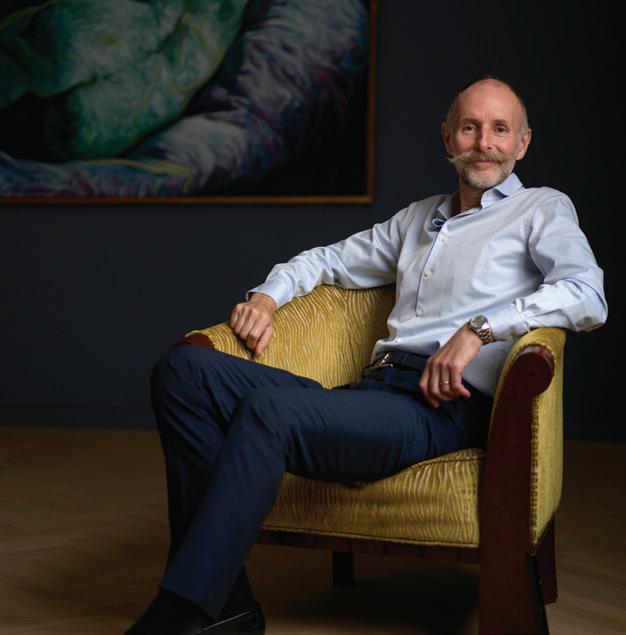
P.24
X+WHY IS A REGISTERED B CORP. BUT WHAT DOES THAT MEAN, AND WHY DOES IT MATTER?
P.42
HENRIETTA RIX OF RIXO ON VINTAGE FASHION AND YOUTHFUL ENDEAVOUR
A new Members Clubspace for The Portman Estate
Meet | Work | Relax
The Orchard at One Great Cumberland Place offers the opportunity to enjoy a unique space for work and socialising, beyond the usual office building amenity. Members enjoy:
• Access to a range of impressive meeting rooms and events spaces
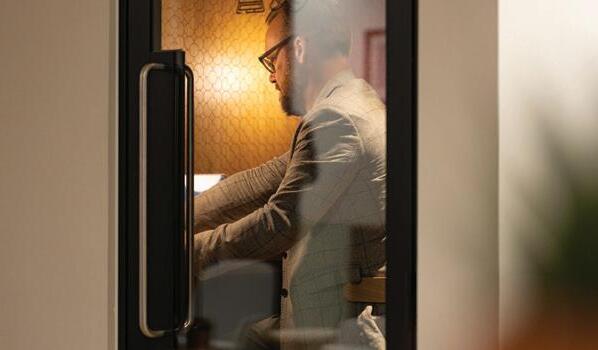
• Breakout desk space for meeting and working
• A cultural programme of events
• A vibrant bar and food offering, with a farm to table ethos, sourced locally and sustainably
• Unrivalled views across London, and an outdoor terrace overlooking Hyde Park
• Sustainable & local suppliers for all food & drink
• The support of our team to ensure you and your guests enjoy your event
The Orchard closes the gap between work and play, creating a unique third space ideal for modern hybrid working and employee engagement.
The Orchard, Level 8, 1 Great Cumberland Place, London, W1H 7AL

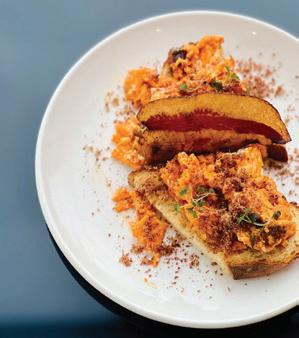

Enquire Now
Marylebone Journal marylebonejournal.com
Marylebone Village marylebonevillage.com
Instagram: @marylebonevillage
Twitter: @MaryleboneVllge
Portman Marylebone portmanmarylebone.com
Instagram: @portmanmarylebone
Publisher LSC Publishing lscpublishing.com
Editor
Mark Riddaway mark@lscpublishing.com
Advertising sales
Donna Earrey 020 7401 2772 donna@lscpublishing.com
Contributers
Jean-Paul Aubin-Parvu
Ellie Costigan
Clare Finney
Orlando Gili
Emily Jupp
Viel Richardson
Design and art direction Em-Project Limited mike@em-project.com
Owned and supported by The Howard de Walden Estate 23 Queen Anne Street, W1G 9DL 020 7580 3163 hdwe.co.uk annette.shiel@hdwe.co.uk

The Portman Estate 40 Portman Square, W1H 6LT 020 7563 1400 portmanestate.co.uk rebecca.eckles@portmanestate.co.uk
MARYLEBONE JOURNAL ISSUE NO.101
BROUGHT TO YOU BY THE HOWARD DE WALDEN ESTATE AND THE PORTMAN ESTATE
HAPPENINGS
3 IN MARYLEBONE Events, exhibitions, film, music, shopping, talks, theatre and walks
IN PROFILE: 14 GLENN BROWN
The painter and sculptor on his Marylebone gallery, appropriating the art of the past, and the struggle of creating an artwork
THE B LIST 24 x+why, the company behind The Portman Estate’s new flexible workspace, is a registered B Corp. But what does that actually mean?
THE DIFFERENCE 33 MAKERS
Matthew Morrison, co-creative producer of the newly restored Soho Poly theatre
A CLOSER 36 LOOK Food, style, home, wellbeing and healthcare
Q&A: 36 ALEXANDRA PETITMENTZELOPOULOS
The owner of Clarette on empowering staff, disdaining wine snobbery and ignoring the ‘rules’ of wine pairing
Q&A: 42 HENRIETTA RIX
The co-founder of RIXO on vintage fashion, LA smoothies and giving up youthful follies to build her brand
ANATOMY OF 50 A DESIGN
Shelley Simpson of Mud Australia on why her approach to ceramics is about much more than creating beautiful objects
1 — MARYLEBONE JOURNAL / ISSUE NO. 101
Cover: Glenn Brown, by Tom Jamieson
nottonart.com
New paintings by Jamie Gallagher
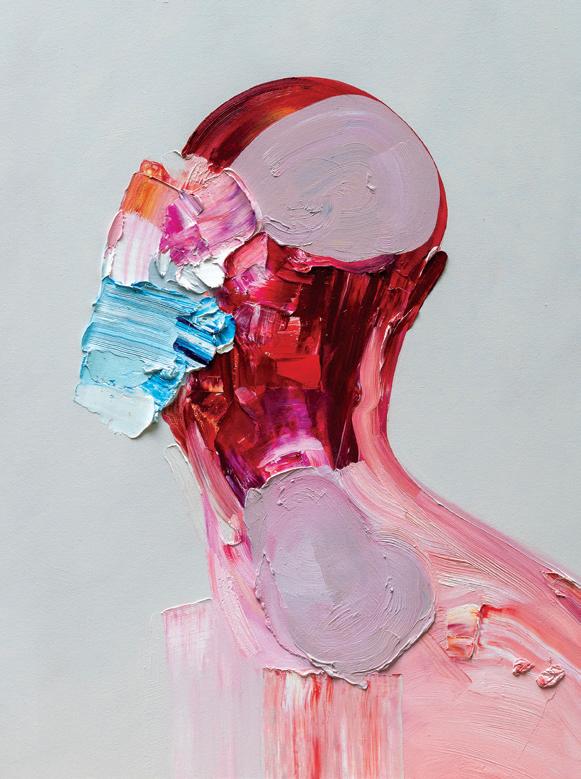
07-23 September 2023
16 Seymour Place, Marylebone, London W1H 7NG
Open Monday- Friday 11-6pm and Saturday by appointment
@nottonart
HAPPENINGS IN MARYLEBONE EVENTS EXHIBITIONS FILM MUSIC SHOPPING TALKS THEATRE WALKS

EVENT
16 – 24 SEPTEMBER
LONDON DESIGN FESTIVAL londondesignfestival.com
The London Design Festival returns in September. Among the local highlights, Mud Australia is launching a porcelain lamp collection, Vitsœ is hosting a two-day event and an evening of talks curated by The Modernist, magazine; Poliform is inviting visitors to explore its Wigmore Street showroom; and Mint is presenting a new exhibition entitled Alchemy of Form.

FILM
FROM 29 SEPTEMBER
THE OLD OAK Regent Street Cinema
307 Regent Street, W1B 2HW regentstreetcinema.com
Against the backdrop of rising tensions caused by an influx of Syrian refugees, the landlord of the last remaining pub in a depressed County Durham town fights to keep it open, striking up an unlikely friendship with one of the refugees along the way. Typically hard-hitting fare from director Ken Loach.

MUSIC
29 SEPTEMBER, 7.30pm
ISATA KANNEH-MASON
Wigmore Hall
36 Wigmore Street, W1U 2BP wigmore-hall.org.uk
Pianist Isata Kanneh-Mason –an ECHO rising star, recipient of both a Leonard Bernstein Award and an Opus Klassik Award and part of a stunningly talented family of musicians – performs a vibrant solo programme of works by Haydn, Fanny Mendelssohn, Schumann and Chopin.

MUSIC
30 SEPTEMBER, 11.30am, 3pm & 7.30pm
WEINBERG FOCUS DAY WITH LINUS ROTH
Wigmore Hall
36 Wigmore Street, W1U 2BP wigmore-hall.org.uk
Violinist Linus Roth is joined by a pool of similarly accomplished musicians to perform three concerts in a single day, all devoted to work of Mieczyslaw Weinberg, a Polish-born Soviet composer whose genius has often been overlooked.
MUSIC
8 OCTOBER, 7.30PM
MAGDALENA KOŽENÁ & MITSUKO UCHIDA
Wigmore Hall
36 Wigmore Street, W1U 2BP wigmore-hall.org.uk
Czech mezzo-soprano
Magdalena Kožená and Japanese-British pianist Mitsuko Uchida are two exceptional individual artists who regularly perform as a duo. Here, they perform works by a pair of French composers, Debussy and Messiaen.
SHOPPING
Spend an afternoon basking in the unique character of Marylebone Lane. Enjoy a raft of promotions, offers, workshops, alfresco drinking and dining, special menus, pop-up stalls, demos, live music and much more, featuring the street’s many retailers and restaurants.
30 SEPTEMBER, 12 – 6PM MEET ME IN MARYLEBONE VILLAGE Marylebone Lane marylebonevillage.com
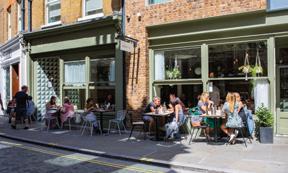
3 — MARYLEBONE JOURNAL / ISSUE NO. 101 HAPPENINGS IN MARYLEBONE
1. Mud Australia, The London Design Festival
2. Isata Kanneh-Mason, Wigmore Hall
3. The Old Oak, Regent Street Cinema
4. Magdalena Kožená, Wigmore Hall
5. Marylebone Lane, Marylebone Village
1.
2.
3.
4.
5.
MUSIC
11 OCTOBER, 7.30pm
ACADEMY JAZZ ORCHESTRA: HEAD HUNTERS
Royal Academy of Music
Marylebone Road, NW1 5HT ram.ac.uk
The Academy Jazz Orchestra celebrates the 50th anniversary of the release of Herbie Hancock’s iconic Head Hunters album. The concert features specially commissioned arrangements of tracks from the album, alongside other works from Hancock’s extraordinary catalogue.
MUSIC
13 OCTOBER, 1pm
TREVOR PINNOCK CONDUCTS

THE ACADEMY CHAMBER ORCHESTRA
Royal Academy of Music
Marylebone Road, NW1 5HT ram.ac.uk
Trevor Pinnock conducts Schubert’s final symphony, nicknamed ‘Great’. This majestic work was written a year after Beethoven’s own Ninth Symphony, and quotes the Ode to Joy theme in reverence of the older composer.
FILM
28 SEPTEMBER – 11 OCTOBER
A LITTLE LIFE Regent Street Cinema
307 Regent Street, W1B 2HW regentstreetcinema.com
Filmed live at the Savoy Theatre, this stage version of the millioncopy bestseller by Hanya Yanagihara has been one of the most sought-after tickets of the year. Starring James Norton, it tells the story of four college friends in New York and the harrowing secrets that one of them is holding on to.

NOTTON GALLERY
Peter Notton has spent more than 25 years working in fine art printing, publishing and curation, working with both world-famous artists and brilliant but underexposed new talents. Now he is for the very first time fronting a gallery of his own, which aims to bring to a wider audience the work of some of the most exciting artists working in the UK today. Over the next few months, Notton Gallery, a beautiful pop-up space on Seymour Place, will host a run of four solo exhibitions.
UNTIL 23 SEPTEMBER
JAMIE GALLAGHER : HYPERPHANTASIA
New paintings by Jamie Gallagher that explore hyperphantasia: a condition in which the mind creates vivid mental imagery that feels entirely real.
28 SEPTEMBER – 14 OCTOBER
HENRICK DELEHAG: MUSCLE MEMORY
Diverse works by Swedish iconographer Henrik Delehag, united by their bold black and white punch and an obsessive preoccupation with faces and patterns.
19 OCTOBER – 4 NOVEMBER
MARZENA ABLEWSKA-LECH: HYPOGEAN
Paintings by Marzena
Ablewska-Lech, which draw from her rich inner world as well as from the flora and fauna of the forests of Pionki, central Poland.
9 NOVEMBER – 2 DECEMBER
JOANNA BAILEY: IRREDUCIBLE FORM
New work by abstract artist Joanna Bailey, whose singular style incorporates textiles, paper, pigment and found ephemera.
NOTTON GALLERY
16 Seymour Place, W1H 7NG nottonart.com
4 — MARYLEBONE JOURNAL / ISSUE NO. 101 HAPPENINGS IN MARYLEBONE
1. A Little Life, Regent Street Cinema
2. Herbie Hancock, Head Hunters, Royal Academy of Music
3. Bestiary 22 by Marzena Ablewska-Lech, Notton Gallery
1.
2.

5 — MARYLEBONE JOURNAL / ISSUE NO. 101 HAPPENINGS IN MARYLEBONE
3.
NEW
EXHIBITION
UNTIL 15 OCTOBER
PORTRAITS OF DOGS: FROM GAINSBOROUGH TO HOCKNEY
The Wallace Collection Manchester Square, W1U 3BN wallacecollection.org
Bringing together over 50 works of art, including paintings, sculptures, drawings and even taxidermy, this exhibition highlights the unique bond between humans and their canine companions across many centuries, showing dogs in all their different shapes and sizes.
THEATRE 10 – 15 OCTOBER
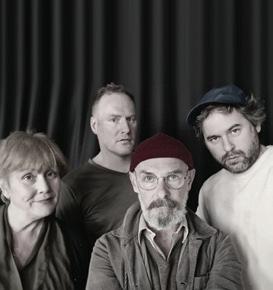
CANNERY ROW
The Cockpit
Gateforth Street, NW8 8EH thecockpit.org.uk
Adapted from John Steinbeck’s novel by Sam Chittenden, Cannery Row explores the lives of the residents of the eponymous street in Monterey, California, during the Great Depression. It celebrates their joy and camaraderie while also highlighting the hardship of the era.
MUSIC
27 OCTOBER, 1pm
SIR MARK ELDER CONDUCTS
THE ACADEMY SYMPHONY ORCHESTRA

Royal Academy of Music
Marylebone Road, NW1 5HT ram.ac.uk
Sir Mark Elder conducts a programme of works from the 1910s: Sibelius’s The Oceanides, inspired by the nymphs of Greek mythology; Ravel’s fairytaleinspired Ma mère l’oye; and Tintagel, Arnold Bax’s tribute to Tintagel Castle in Cornwall.
EXHIBITION
14 SEPTEMBER – 28 OCTOBER
RYAN GANDER: PUNTO! Lisson Gallery
27 Bell Street, NW1 5BY lissongallery.com
Ryan Gander presents a new animatronic installation that questions the obsession with the economics of growth over stasis and stability. This is joined by a series of bronze figurative works and a documentary, originally made for the BBC, both relating to the masks we choose to wear and the masks that wear us.
EXHIBITION
The Autumn Exhibition is an opportunity to showcase the Thompson’s Gallery entire approach in one carefully curated show. It features diverse works from more than 100 artists of different ages and profiles, including renowned Modern British painters such as Fred Cuming and Terry Frost.

19 SEPTEMBER – 14 OCTOBER
AUTUMN EXHIBITION
Thompson’s Gallery
3 Seymour Place, W1H 5AZ thompsonsgallery.co.uk
Hall
6 — MARYLEBONE JOURNAL / ISSUE NO. 101 HAPPENINGS IN MARYLEBONE
1. On The Thames by Simeon Stafford, The Autumn Exhibition, Thompson’s Gallery
2. Cannery Row, The Cockpit
3. Academy Symphony Orchestra, Royal Academy of Music
4. Li Ran, Lisson Gallery
5. Marylebone Christmas Lights
6. Errollyn Wallen, Wigmore
1.
2.
3.
MUSIC
28 OCTOBER, 1pm
ERROLLYN WALLEN
Wigmore Hall
36 Wigmore Street, W1U 2BP wigmore-hall.org.uk
The Belize-born British musician Errollyn Wallen is one of the UK’s most acclaimed contemporary composers, a recipient of a CBE and winner of an Ivor Novello award. She will be performing songs from The Errollyn Wallen Songbook alongside some of her solo piano works.
EXHIBITION
14 SEPTEMBER – 28 OCTOBER
LI RAN: WAITING FOR THE ADVENT Lisson Gallery


67 Lisson Street, NW1 5DA lissongallery.com
Chinese artist Li Ran’s first solo exhibition in London presents a selection of video works, paintings and texts that collectively interrogate what it is to be a creative individual working within the complex social and political landscape of contemporary China.
EVENT
Marylebone Village’s Christmas season kicks off with the traditional celebrity switch-on moment: the centrepiece of a whole day of festive activities and offers. Marylebone High Street and much of the surrounding area will be pedestrianised to make way for the usual live music, children’s activities, stalls, and charity fundraising on behalf of Mind Brent, Wandsworth & Westminster. Dozens of retailers and restaurants will be offering promotions, experiences, gifts and special menus.
9 NOVEMBER, 3-8pm
MERRY MARYLEBONE CHRISTMAS LIGHTS & SHOPPING EVENT Marylebone Village marylebonevillage.com
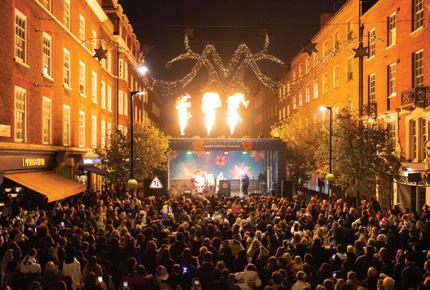
ART TRAIL
UNTIL 29 OCTOBER
FIND THE WORDS
Portman Marylebone portmanmarylebone.com
Find the Words is an uplifting area-wide art installation created by street artist Andy Leek, who is known for creating artworks covered with optimistic messages and secreting them into the urban landscape. Dotted through the whole of the Portman Marylebone area, his pieces range from bunting and plants to laser-cut installations, to shop signs.
MUSIC
31 OCTOBER, 11am-6pm
AUTUMN PIANO FESTIVAL Royal Academy of Music
Marylebone Road, NW1 5HT ram.ac.uk
Curated by Professor Joanna MacGregor, this year’s Autumn Piano Festival offers a rare chance to spend a full day experiencing the complete Années de pèlerinage: 26 of Liszt’s finest pieces for solo piano, written over a period of nearly 40 years in three distinct suites.
7 — MARYLEBONE JOURNAL / ISSUE NO. 101
IN
HAPPENINGS
MARYLEBONE
4.
5.
6.
Q&A: KIMBERLEY GUNDLE

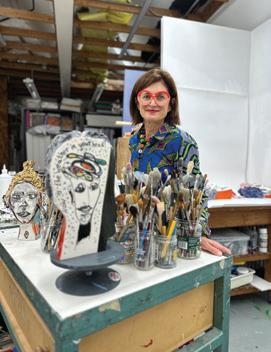
The artist on documenting people, working in many media and creating a visual diary of the Covid year
Interview: Ellie Costigan
When did you start making art?
I drew and painted all through my youth. In South Africa, I attended Michaelis School of Fine Art. I did a BA in fine art, followed by a postgraduate, and then a master’s in painting. I’ve spent the last 45 years documenting the people around me –people have always been central to my art practise.
How so?
It’s more about capturing the essence of a person, as opposed to a representation in a photographic sense. I came to London in 1988 and was fairly isolated. I didn’t really know how to anchor myself. So, I started sketching the people on the London Underground. I still do it, to this day. In 2009, I walked across the Great Rift Valley, which runs between Kenya and Tanzania, for a charity. I came across the Maasai and I was so drawn to them, especially the women. They’re all beautifully adorned. We complain when the water’s too cold to wash our hair; they have to walk for miles for water. For the next eight years, I returned to many different Maasai communities and started documenting them. But all through that time, I continued drawing on the underground. It’s a way of engaging, forgetting about time, sharing glances. Creating some kind of connection with people.
Who or what tends to spark inspiration?
I’ve never been interested in drawing the whole person. I’m more interested in the lines etched into skin, for example, which tell some kind of story. I spent a slice of time doing portraits below the knee. A little girl in ballet shoes, a person in very high heels, someone in their football boots. You choose how you want to represent yourself with your shoes. But how you perceive yourself and how I perceive you are going to be very different, especially if it’s not a photographic portrait.
You use a wide variety of media in your work. Is it always obvious which you’ll use for the final piece or collection?
I use whatever works to my benefit. When I was walking the Great Rift Valley, I did sketching and photography and then developed those pieces using drawing and screen printing for the first exhibition. In the second, I did wash and water colour,
then the third exhibition was all ceramics. I kind of taught myself as I went along, for my own amusement –though that’s not quite the right word. I like to explore different media. During Covid, my daughter was sent home from university. She said: “Mum, I just want to be free! I want to do the splits.” So, I made a papiermâché woman with her legs dancing, doing the splits, coming out of a metal flower. It was a bit bigger than life size. I then added fibreglass and painted it. It’s now an outdoor sculpture, in my front garden. People stop and look at it every day. I learnt how to do that on YouTube, actually!
Tell us about your upcoming exhibition at 67 York Street. What can we expect?
I’ve called the exhibition How is the Weather in Your Head? On 20th March 2020, I started documenting a thought a day, creating a visual diary on Instagram. I still do it, each night. I found that I had a collection of thoughts and days, so I
8 — MARYLEBONE JOURNAL / ISSUE NO. 101
HAPPENINGS IN MARYLEBONE
1.
made a book called Navigating the Maze. It documents how our world changed in that year, from when the Brexit deal was done to the arrival of the Covid vaccine, to summoning resilience, to mask-wearing. I made 300 copies of the book and each is accompanied by a ceramic talisman. Because in Covid everyone was quite isolated, I thought, the book needs a companion! At the exhibition, I’m going to have some of my books for sale and then people can choose or make their own talisman to accompany it. I’d like people to come and join me for tea and to have a conversation. I’ll be at the gallery throughout the exhibition.
The other thing I’ve made for the exhibition is portraits inspired by people on the underground. They’re ceramic, then on the back are some of my thoughts. I’ll have a selection of these on show. This is the first time I’ve exhibited at 67 York Street –I just walked past and thought it looked like a nice space. I went to see two exhibitions there, to get a feel for it. I’m that kind of person: I just make a decision, run with it and pray.
What role do you think art has to play in turbulent times?
For me, starting the visual diary on Instagram was a way of being able to connect with people. I’d upload my daily post and people would send comments: “Looking through your daily posts at 4am, I suddenly feel less alone and comforted by your reflections, which often mirror mine”; “It’s given me a different perspective in these strange times”; “Your posts every day have become like a second news and remind me to take a moment in all this chaos”. I don’t know any of these people. I think art does that: it does give people a voice and a way of connecting. It’s my anchor in this world.
19 – 30 SEPTEMBER
KIMBERLEY GUNDLE: HOW IS THE WEATHER INSIDE YOUR HEAD?
67 York Street
67a York Street, W1H 1QB 67yorkstreet.com
WALK
31 OCTOBER, 6pm HALLOWEEN WALK Baker Street Quarter Partnership bakerstreetq.co.uk

Kicking off at 6pm from 55 Baker Street, this Halloween edition of the Baker Street Quarter Partnership’s programme of free guided walks takes in some of the many ghostly corners of this most historic, atmospheric and – it would seem – haunted of areas.
MUSIC
1 NOVEMBER, 7.30pm
VERONIKA EBERLE & DÉNES VÁRJON
Wigmore Hall
36 Wigmore Street, W1U 2BP wigmore-hall.org.uk
German violinist and Wigmore
Hall artist in residence Veronika Eberle is joined by Hungarian pianist Dénes Várjon for performances of Beethoven’s mighty Kreuzer sonata, two rhapsodies from Bartók, and Frank’s Sonata in A for violin and piano.

SPOKEN WORD
8 NOVEMBER, 7.30pm
PETER OSWALD: EGIL

Marylebone Theatre
Rudolf Steiner House
35 Park Road, NW1 6XT marylebonetheatre.com
Poet and performer Peter Oswald provides a typically energetic reading of Egil, his epic retelling of an old Icelandic saga. The eponymous hero is a Viking warrior-poet who traverses the North Sea, grappling with his enemies using the weapon of thunderous verse.
THEATRE
14 SEPTEMBER – 4 NOVEMBER
THE WHITE FACTORY Marylebone Theatre
Rudolf Steiner House 35 Park Road, NW1 6XT marylebonetheatre.com
The White Factory, written by Russian political exile Dmitry Glukhovsky, tells the story of Yosef Kaufman, a Holocaust survivor from the Polish city of Lodz, who is trying to build a new life in 1960s Brooklyn while haunted by the ghosts of a brutal past.
9 — MARYLEBONE JOURNAL / ISSUE NO. 101
1. Kimberley Gundle, 67 York Street
2. Veronika Eberle, Wigmore Hall
3. Halloween Walk, Baker Street Quarter Partnership
4. Peter Oswald, Marylebone Theatre
HAPPENINGS IN MARYLEBONE
2.
3.
4.
SPOKEN WORD
9 NOVEMBER, 7.30pm
AN EVENING WITH SIMON ARMITAGE
Marylebone Theatre
Rudolf Steiner House 35 Park Road, NW1 6XT marylebonetheatre.com
A rare chance to see poet laureate Simon Armitage live in London. He will be reading a selection of his own poetry, as well as modern translations of Middle English masterpieces, such as Gawain and the Green Knight, Pearl, and The Death of King Arthur.

MUSIC
10 NOVEMBER, 1pm
SEPTURA: SIDE-BY-SIDE Royal Academy of Music
Marylebone Road, NW1 5HT ram.ac.uk
In this free concert, members of brass ensemble Septura and Academy students explore the jazz idioms and classical forms of Gershwin’s Piano Preludes, the Western and Indian classical scales of Reena Esmail’s A Winter Breviary, and the neoclassicism of Stravinsky’s Pulcinella.

SPOKEN WORD
11 NOVEMBER, 2.30pm & 7.30pm
FORGOTTEN VOICES

Marylebone Theatre
Rudolf Steiner House
35 Park Road, NW1 6XT marylebonetheatre.com
For this Remembrance Day performance, directed by Gerrard McArthur, a cast of actors recreate the moving oral testimonies of five people whose lives were utterly transformed by the First World War, transcribed from sound archives kept by the Imperial War Museum.
EXHIBITION
Vlassis Caniaris, one of the most important Greek artists of the 20th century, created what he called ‘almost sculptures’: sculptural works made with plaster, paper, wire mesh and everyday objects such as clothes and toys, rather than traditional materials. Most of the works on display, including large-scale installations and smaller, wall-based pieces, tackle themes of immigration and inequality that preoccupied the artist throughout his life.
5 OCTOBER – 18 NOVEMBER
VLASSIS CANIARIS: SELECTED WORKS 1960S – 1980S
The Hellenic Centre 16-18 Paddington Street, W1U 5AS helleniccentre.org

10 — MARYLEBONE JOURNAL / ISSUE NO. 101
HAPPENINGS IN MARYLEBONE
1. Simon Armitage, Marylebone Theatre
2. Septura, Royal Academy of Music
3. Possible Background by Vlassis Caniaris, The Hellenic Centre
4. Can’t See For Looking, The Cockpit
5. Food Market at 55 Baker Street
1.
2.
3.
4.
THEATRE
18 OCTOBER – 14 NOVEMBER

CAN’T SEE FOR LOOKING
The Cockpit
Gateforth Street, NW8 8EH thecockpit.org.uk
Based on extensive interviews with Filipina domestic workers rescued from modern slavery, this powerful play by Carolyn Lloyd-Davies and Franchezka Cunanan tells the story of Rosa, who finds herself enslaved in London, desperate to escape, sustained only by her religious faith and love of karaoke.
FOOD
STREET FOOD MARKETS
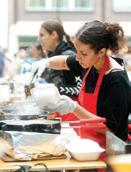
Baker Street Quarter Partnership bakerstreetq.co.uk
The Baker Street Quarter’s fortnightly Thursday food market has returned to the covered atrium of 55 Baker Street, with a small but diverse range of independent street-food stalls offering a mouthwatering alternative to the usual workday lunch. A new weekly food market is also popping up at George’s Pocket Park, complete with weather-proof gazebo.
11 — MARYLEBONE JOURNAL / ISSUE NO. 101
HAPPENINGS IN MARYLEBONE
5.
EXHIBITION
Patrick Demarchelier, the French-born photographer whose work with American Vogue brought genuine artistry to the world of fashion photography, passed away last year. This exhibition, his very first major UK solo show, evinces his unequalled eye for both fashion and portraiture.
29 SEPTEMBER – 18 NOVEMBER
PATRICK DEMARCHELIER: LEGACY

Atlas Gallery
49 Dorset Street, W1U 7NF atlasgallery.com
WALK
15 NOVEMBER, 12PM
BAKER STREET LITERARY
GREATS WALK
Baker Street Quarter Partnership bakerstreetq.co.uk
Kicking off from 55 Baker Street, this free guided walk from the Baker Street Quarter Partnership explores landmarks associated with the rich literary history of Marylebone, including the local haunts of great writers such as Charles Dickens and Arthur Conan Doyle.
EXHIBITION
5 OCTOBER – 18 NOVEMBER
AMY STEPHENS: OBJECTS OF WONDER
The Hellenic Centre
16-18 Paddington Street, W1U 5AS helleniccentre.org
During her residency at Nicosia Municipal Arts Centre in Cyprus last year, British artist Amy Stephens created this series of photographic and mixed media artworks in response to artefacts found in the Cypriot landscape.

3.
MUSIC
21 – 24 NOVEMBER, 7pm
ROYAL ACADEMY OPERA: ARIODANTE
Royal Academy of Music
Marylebone Road, NW1 5HT ram.ac.uk
In a production directed by Olivia Fuchs and conducted by David Bates, Academy students present one of Handel’s darkest operas. Ariodante and his beloved Ginevra find themselves enmeshed in a treacherous web of deceit. Will their love survive?
EXHIBITION
15 SEPTEMBER – 25 JANUARY
SUMI KANAZAWA: ERASE AND SEE Daiwa Anglo-Japanese Foundation

13-14 Cornwall Terrace, NW1 4QP dajf.org.uk
This exhibition by Japanese artist Sumi Kanazawa includes Drawings on Newspapers, a work created by using a black 10B pencil to excise printed words and images from newspapers, leaving intact only those that appealed to her.
EXHIBITION
UNTIL 31 JANUARY
EDWARD JENNER: A LIFE IN LETTERS
Royal Society of Medicine Library
1 Wimpole Street, W1G 0AE rsm.ac.uk
Drawn from his personal correspondence, this free exhibition in RSM Library provides an extraordinary insight into the life and thoughts of Edward Jenner, creator of the world’s first vaccine and an attendee at the inaugural meeting of the RSM.

12 — MARYLEBONE JOURNAL / ISSUE NO. 101
1. Alana Zimmer, Moschino, Paris by Patrick Demarchelier, Atlas Gallery 2. Kouklia y Amy Stephens, The Hellenic Centre
Handel’s Ariodante, Royal Academy of Music
HAPPENINGS IN MARYLEBONE
4. Edward Jenner, Royal Society of Medicine Library
1.
2.
3.
4.
How is the weather in your head?
Edward Jenner: A life in letters














An exhibition showcasing a collection of unpublished letters from the great English vaccine pioneer, recently transcribed by staff at the RSM library.
Monday - Thursday: 9:30am - 6:00pm




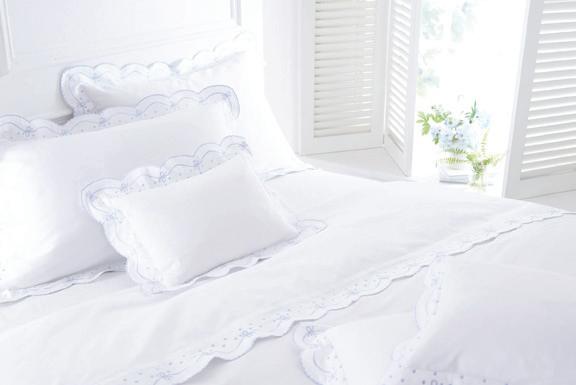
Friday: 9:30am- 5:30pm Saturday - Sunday: Closed Now open Free admission
The Library, Royal Society of Medicine, 1 Wimpole Street, London, W1G 0AE
WWW.COLOGNEANDCOTTON.COM 88 MARYLEBONE HIGH STREET, LONDON W1
FOR BEAUTIFUL LIVING
EXHIBITION EVENTS BOOK LAUNCH 23 SEPTEMBER 2023 11.30AM
MAKING 3.30
4.30PM
TALISMAN
-
67 YORK STREET GALLERY 67A YORK STREET, LONDON W1H 1QB
| @KIMBERLEY_GUNDLE_STUDIO
11:30
PRIVATE VIEW
13 — MARYLEBONE JOURNAL / ISSUE NO. 101
@KIMBERLEYGUNDLE
19TH - 30TH OF SEPTEMBER
AM – 6:30 PM
19TH SEPTEMBER 6 PM - 9 PM WWW.KIMBERLEYGUNDLE.COM
GLENN BROWN IN PROFILE
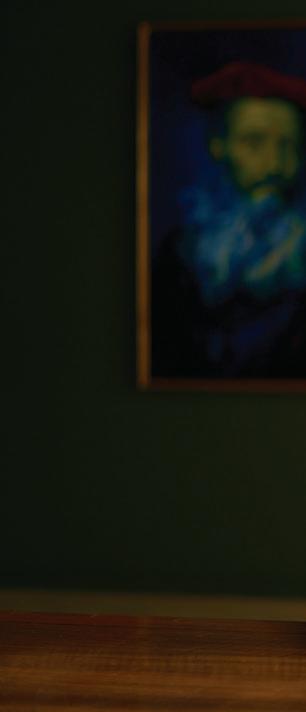
Words: Mark Riddaway
Images: Tom Jamieson, Lucy Dawkins, Mike Bruce, Rob McKeever
14 — MARYLEBONE JOURNAL / ISSUE NO. 101
The painter and sculptor on his Marylebone gallery, appropriating the art of the past, and the excruciating struggle of creating an artwork
IN PROFILE: GLENN BROWN

15 — MARYLEBONE JOURNAL / ISSUE NO. 101 IN PROFILE: GLENN BROWN >
We’re on one of the upper floors of a gallery in a large mews house just off Marylebone Lane, standing in front of a huge oil painting. This painting – like the many other canvasses and sculptures we’ve passed on our tour of this beautifully refurbished space – is by Glenn Brown, the man whose name adorns the building: The Brown Collection. Glenn is among the UK’s foremost artists, a man whose exhibitions have graced the world’s great museums and galleries. He’s also one of the chosen few on the books of Gagosian, the dealership that shaped the contemporary art market and acts as catnip for insanely wealthy collectors – a sign (as if this gorgeous
four-storey period building weren’t clue enough) that Glenn’s singular artistic vision has been parlayed into enviable commercial success.
So anyway, this painting. Its title is Shipwreck, Custom of the Sea. Like all of Glenn’s work, its form has been directly (and completely unapologetically) appropriated from art of the past. Here, the main source is Van Gogh’s Still Life with Quinces, a small painting of a pile of fruit on a sparkling swatch of blue cloth. Even if, like me, you can’t call to mind this minor entry in the Dutchman’s canon, it’s still hard not to be struck by the essential Van Gogh-iness of Glenn’s much larger composition. But
this isn’t a reproduction, it’s a cover version – like Devo doing (I Can’t Get No) Satisfaction: instantly familiar but warped into something clever and unsettling.
Where the Dutch artist’s quinces were perky and golden, Glenn’s are putrid, corrupt, collapsing. Van Gogh’s cloth is now a rippling seascape. From the form of the fruit pile, you might see a Giacometti sculpture of a human body, albeit a very dead-looking one. In the outline of the quinces, there’s a strong echo of Théodore Géricault’s The Raft of the Medusa. (These visual references are particularly easy to spot if, like me, you’re having them gently pointed out by Edgar Laguinia,
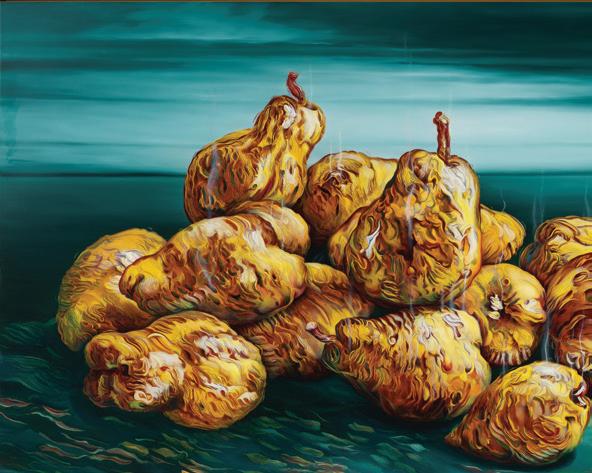
IN PROFILE: GLENN BROWN 16 — MARYLEBONE JOURNAL / ISSUE NO. 101
Shipwreck, Custom of the Sea, a large oil painting almost three metres wide, created in 2022. Its composition brings together a Van Gogh still life, a Giacometto figure and Théodore Géricault’s The Raft of the Medusa
that subtext comes rushing through. Van Gogh. Géricault. Giacometti. Distortion. Disaster. Cannibalism. Putrefaction. Death.
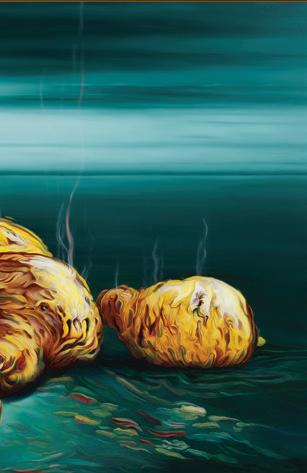
The gallery spills over with similar appropriations, all of them rich with visual puns and wordplay, allusions to history and myth, high culture and pop culture. There’s a grotesque marrying of a Rubens portrait and Michelangelo’s The Creation of Adam. There’s a headless mother with a deathly blue pallor and a bloody finger, melding a Eugène Delacroix sketch and René Magritte’s nippleeyed, vagina-mouthed woman. There’s a sculpture that references Giacometti, Picasso, Pinocchio and Elvis Presley. None of it, though, is for sale. The Brown Collection is Glenn’s own personal collection; works that he loved too much to let leave or worked hard to re-acquire. And he wants you to come and see them.
Glenn’s husband, who manages the gallery.) The Medusa was a French naval frigate that ran aground in 1816. Of the 147 people who boarded an unstable 20m-long raft constructed from the wreckage, only 15 were eventually rescued. Some had resorted to eating their fellow passengers, a practice at least tacitly accepted within a maritime tradition known as ‘the custom of the sea’.
The painting has an appeal that is instant and unintellectual: you need know nothing of art history or nautical lore to enjoy its aesthetic punch or smile at how a pleasant fruit bowl has been subverted into something rancid. But with just a little prompting, all
Initially, Glenn and Edgar had been looking for an office space in Marylebone. “And somehow that office transformed itself into an exhibition space. Just because,” says Glenn, dialling in from his studio in Suffolk over patchy parochial wifi. For some artists, creativity is a form of self-expression that ends once the expressing has been done. For Glenn, whose intent is something more considered, placing a painting or drawing in its frame is just a step along the way. “I consider art to be an act of communication more than it is self-expression,” he says, “and in order for that communication to happen people need to see the work. This was the best way I could get people to see it, I thought: a collection of work I’ve curated, in an environment I’ve chosen.”
Because he’s quite often present, visitors might have the unusual experience of viewing the art in the presence of the artist. Not that everyone appreciates the opportunity. “It’s strange,” he says, “but sometimes I realise that people aren’t keen for me to be there. I’ve noticed some people being a bit uncomfortable or even a
IN PROFILE: GLENN BROWN 17 — MARYLEBONE JOURNAL / ISSUE NO. 101 >
“I consider art to be an act of communication more than it is selfexpression, and in order for that communication to happen people need to see the work.”
bit annoyed. I just have to leave them to look. But that’s okay: it’s not about me, it’s about the work. That’s how I choose to entertain people – via my work, not myself.”
So, if his work isn’t about himself, what is its source? How did he come to be painting paintings of paintings? “French post-structuralist philosophy,” he says, causing me to laugh out loud at this uncompromisingly cerebral response. Glenn – as calm and precise in person as he is with his brush strokes – doesn’t flinch.
One conclusion that can be drawn from the work of 1960s thinkers such as Jacques Derrida and Gilles Deleuze, he continues, is that an object or text can only make sense if the person observing it understands the specific language or cultural context that informed its creation. “Therefore, it’s impossible to make something completely original: if you make something that’s truly original it won’t make any sense. Something outside of language and outside of culture would mean nothing to anybody. It would be completely useless.”
By extension, it’s impossible to create art in a vacuum. All art – all creativity – is shaped by external influences. Even those avant-garde artists who choose to emphasise their newness are, in their own way, responding to the art of the past, if only to reject it. Like all artists, Glenn draws on what came before, but rather than pretend he’s never even met his influences, he drags them to the party and gets them drunk on his own special hooch. The result, he believes, is as original as any other art. “Even though I make work based on other artists’ work, my paintings have never existed before,” he says. “I think when somebody sees one of my paintings, they recognise that it’s mine immediately.”
Born in Northumberland in 1966 and brought up in rural Norfolk, Glenn loved art from an early age, despite his lack of proximity to the galleries and museums that would later shape his work. “I always drew,” he says. “I think
it’s the thing I like doing more than other activity.” When he discovered a path through the education system that involved drawing every day, he threw himself along it, studying at Norwich School of Art, then Bath Academy of Art, before eventually making his way to London for an MA at Goldsmiths College. It was thanks in part to his circuitous route to the bright lights of London that Glenn was imbued with his unusually fine technical skills as a draftsman and painter. “In Norwich, life drawing was at the heart of the art college,” he explains. “By the time I got to Goldsmiths there was no life drawing at all. To them, that would have been a
Fail We May, Sail We Must, a work from 2022 in India ink, acrylic and oil. The main references are Michelangelo’s The Creation of Adam from the Sistine Chapel ceiling, and a portrait by the Flemish master Peter Paul Rubens
“Even though I make work based on other artists’ work, my paintings have never existed before, I think when somebody sees one of my paintings, they recognise that it’s mine immediately.”
completely weird thing to do, to draw or paint anything from life. Didn’t seem appropriate.”
At the end of the 1980s, Goldsmiths was a bubbling crucible of innovation. But although Glenn was a contemporary of the young British artists who would go on to be known, deeply unimaginatively, as the Young British Artists – Sarah Lucas, Damien Hirst, Gillian Wearing and the rest of the Freeze / Saatchi / Sensation crowd – he has rarely been lumped in with them. Presumably because he chose passé oil paint over the brave new world of neon tubes and embalmed animals. Ask him to identify his artistic tribe and he will
18 — MARYLEBONE JOURNAL / ISSUE NO. 101 IN PROFILE: GLENN BROWN

IN PROFILE:
BROWN > 19 — MARYLEBONE JOURNAL / ISSUE NO. 101
GLENN
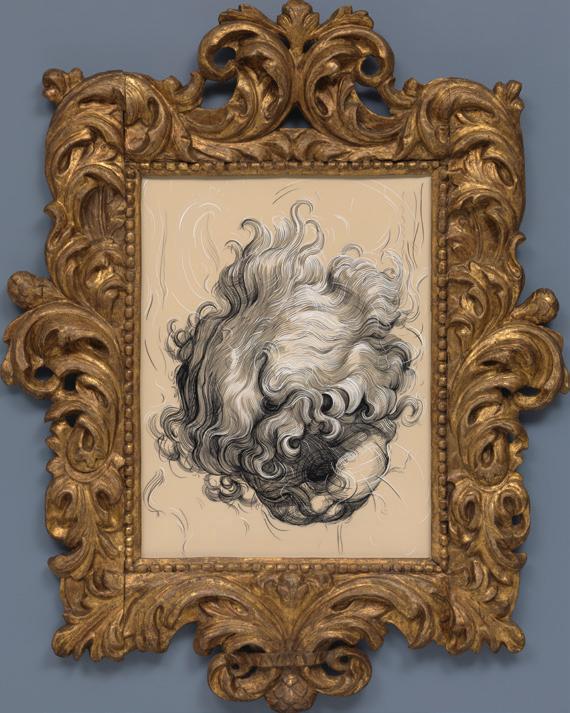
IN PROFILE:
20 — MARYLEBONE JOURNAL / ISSUE NO. 101
GLENN BROWN
Fat Boy (1945), a 2018 piece in India ink and acrylic paint. It is based on a piece by the 16th-17th century Dutch Mannerist artist Abraham Bloemaert and set in an Italian Baroque scrolling leaf frame
Francis Bacon and Lucian Freud. “He made very thick, gooey, impasto paintings,” says Glenn. “He used lots of paints. He did that with thick, gestural brush strokes, which is the complete opposite of what I did. I made these very tight, delicately drawn paintings that took a long time to make and were very slow and precise, and Frank Auerbach’s work was quick and loose and full of gesture. I thought, if I’m going to paint a painting of a painting then let’s start with something that’s the opposite of what I’ve been doing.”
Few people today are likely to recognise the imprint of an Auerbach, but for Glenn that’s part of the point. The paintings he chooses as his models are only occasionally as familiar as a Van Gogh still life or the Sistine Chapel ceiling. Most are notable for their obscurity. “I like to try to educate people about artists they wouldn’t necessarily know about,” he says. “The fact that somebody becomes successful and famous is not necessarily based on how brilliant they are – there can be lots of other accidents in life that make somebody famous. As a result, there are lots of brilliant artists who nobody’s heard of. I like to champion the underdog to some degree.”
tell you he’s a Mannerist. “Mannerism was a European school of art that existed between 1600 and 1800 and it’s all about the transformation and the distortion of the human body and nature,” he explains. “I distort the human figure enormously. I tell stories by the way it’s distorted.”
Unlike many artists, who bounce from idea to idea through their formative years before developing a real sense of their calling, Glenn hit his stride at a remarkably young age. His techniques have shifted and evolved, so too his processes for planning and producing a piece, but his collection retains an unusual coherence of philosophy, despite representing
several decades of endeavour. Unlike many artists, he doesn’t even hate his old stuff. “Some of the old works I like more than others, but I was a different person when I made them, and I like that,” he says. “Sometimes I have to struggle with myself not to go back and change things, because I always think I can improve. I only consider a painting finished when I give up on it. It’s not, ‘Oh, fantastic, it’s finished,’ it’s really a case of, ‘I don’t know what to do anymore with this painting. Therefore, it’s finished.’”
Many of Glenn’s earliest acts of larceny involved paintings by Frank Auerbach, who was part of the 1960s London art scene that spawned
As with those Auerbach portraits, what pulls Glenn in is often not so much a painting’s subject as its most elemental form: the brush strokes or the pencil lines, the sense of each artist’s presence. “Art involves abstracting the world through your brush stroke or pencil line,” he says. “To some extent, what I paint is other people’s gestures and marks.” On a basic level, he also has to like the work. “If I don’t really enjoy the delicate qualities of a painting, or how clever it is, I get bored because I’m spending days or months looking at it.”
Recently, he’s spent almost as much time staring at antique picture frames as at other people’s paintings. In 2017, Glenn’s work was shown at the Bardini Museum in Florence, alongside medieval and renaissance masterpieces
> IN PROFILE: GLENN BROWN 21 — MARYLEBONE JOURNAL / ISSUE NO. 101
“Each frame has an individual identity – it guides the subject matter, the colour, the scale. It pushes you to do certain things. With most of the drawings that I make now, the starting point is the frame.”
from the museum’s collection. “And they had this wonderful collection of old frames with no paintings in them,” he explains. “I started making drawings specifically for those frames and I enjoyed the process so much. Each frame has an individual identity –it guides the subject matter, the colour, the scale. It pushes you to do certain things. I like having a frame which is guiding me as well as images by other artists. With most of the drawings that I make now, the starting point is the frame. It’s a different way of working but it challenges me and inspires me.” Their Marylebone house, Edgar tells me, is now as much a frame repository as a home.
Opposite: Die Mutter a Künstlers [‘the mother of the artist’], an oil painting from 2016. The main sources are a Eugène Delacroix sketch and René Magritte’s famous Le Viol, a work that referenced the suicide of the surrealist artist’s mother
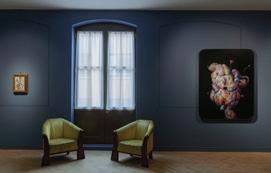
and references that bleed into his art, Glenn has now added old woodwork.
Whatever his starting point, Glenn approaches each piece with a clear idea of the destination. “I do a lot of preparatory work, drawings and paintings, and I work on the computer to get something that looks as close as possible to the finished painting.” The road, though, is rarely smooth. “By the time it comes to the actual painting, it all drifts off and you encounter loads of problems. I always struggle. It’s like fighting, trying to get the painting to work. Each one takes many months of fighting, trying to balance the whole thing up so the composition works and the depth works and the colour works.”
Fat Boy (1945) is a case in point: a drawing based on a piece by the obscure Dutch Mannerist painter and printmaker Abraham Bloemaert. The image is ostensibly the head of a plump-cheeked child, but there’s a sense of downward propulsion to the portrait, as if the head is dropping from the sky. The title is an amalgamation of Fat Man and Little Boy, the nicknames given to the two atom bombs that eviscerated Nagasaki and Hiroshima in August 1945. The Italian Baroque frame was the starting point, its extravagantly flaring leaves suggestive of both the child’s billowing hair and a nuclear explosion. To the stable of influences
Ultimately, he embraces that struggle. “Generally, if you come to a painting a little bit too easily it’s not a good painting. People like to see a bit of a fight on the canvas. They like to see the struggle. It’s a story, it tells a story: the struggle of making a painting.” And despite the solitary nature of his work, he isn’t entirely alone in that fight. “Edgar comes in regularly and says: ‘You need more blue’ and ‘This is unbalanced’ or ‘This is just hopeless, start again.’ I also have friends – artists – that come in and help. I help them as well, you know. I meet other artists in their studios and we talk about art. That’s what you do, you help each other. It’s important to understand that you can get stuck in your own ways, and that’s not the best thing. You need to break outside of yourself sometimes – to view your own work as if you’re somebody else. As if you’re the viewer, not the artist.”
Which brings us back to the entire point of this place. A space where he can be a viewer and be surrounded by other viewers, responding to and talking about his art. If he’s there, he’ll be part of that conversation. Unless, like some, you really don’t want him to be – in which case he promises to leave you alone.
THE BROWN COLLECTION

1 Bentinck Mews, W1U 2AF
glenn-brown.co.uk
22 — MARYLEBONE JOURNAL / ISSUE NO. 101 IN PROFILE: GLENN BROWN
Left: The Bown Collection on Bentinck Mews
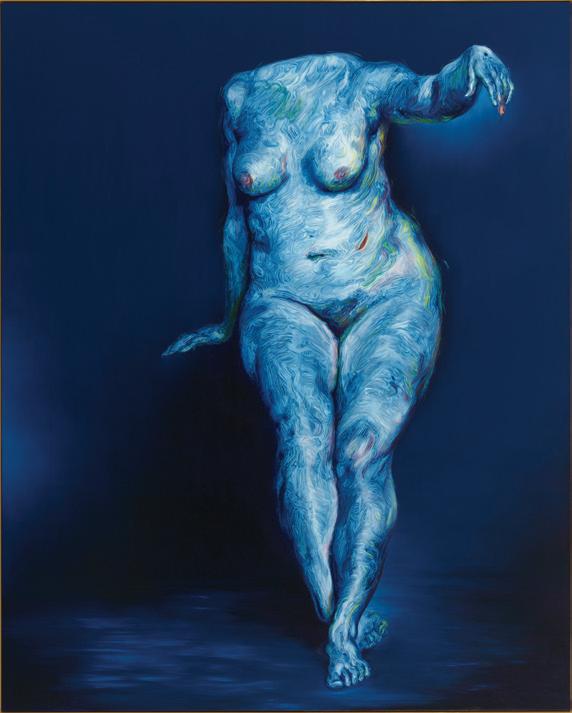
IN PROFILE: GLENN BROWN 23 — MARYLEBONE JOURNAL / ISSUE NO. 101
THE B LIST
Flexible workspace operator x+why, which has recently opened new premises on The Portman Estate, has added to Marylebone’s burgeoning list of B Corp companies. But what is a B Corp and why does the accreditation matter?
Words: Clare Finney
24 — MARYLEBONE JOURNAL / ISSUE NO. 101 THE B LIST
In November 2022, Hope – the magnificent 25-metre-long blue whale skeleton suspended from the ornate ceiling of the Natural History Museum’s main hall – looked on as representatives from hundreds of companies came to celebrate the number of British businesses certified as B Corps passing the 1,000 mark. To Hope, a creature whose sense of scale operates on a whole different plane, it might not have seemed that much of a milestone; but to the humans at the museum, there was reason to rejoice in the size and rapid growth of the B Corp movement – a movement which, in a nutshell, encourages businesses to work as a force for good. Today, the figure for the UK has passed 1,500, most of which are in London and several of which are in Marylebone; doubtless there will be more by the time this article comes out. Yet despite this city being home to one of the fastest-growing communities of B Corps in the world, many of us know little better than the average blue whale would what this actually means in practice.
“We’ve been a B Corp for four years now, and you’re only maybe the fourth person to speak to me about it,” says Victor Lugger, co-founder and CEO of the restaurant group, Big Mamma, which includes Marylebone’s Carlotta restaurant among its number. Even those people who have heard of B Corp often misunderstand the breadth of its purpose. “There are various misconceptions, the most common being that B Corp is all about the environment,” says Phil Nevin, the co-founder and CCO of x+why, a provider of flexible workspaces.
Phil’s company’s new premises at One Great Cumberland Place include two floors of office space and a co-working membership club called The Orchard, in a new building owned by The Portman Estate (itself a B Corp since 2022 – the first of London’s historic estates to receive the accreditation). As well as offering everything you’d expect from such a space – meeting rooms, events spaces, dining and private dining areas – x+why runs workshops and programmes to help its members achieve their own certification. “As well as wanting to be a B Corp, we wanted to amplify the work of others, and spread the message of what B Corp is,” says Phil. He draws a comparison with Fairtrade. “We know the Fairtrade sticker, and we know what it means. We know from that sticker that the farmer gets paid and that the labour practices in the supply chain are above board. I have a cheap line that B Corp is like a Fairtrade sticker for business,” he continues. “But I think we as a group of B Corps do need to define better what a B Corp actually is.”
“So what is it?” you may be screaming by now. What unites B Corp companies is, the official blurb states, their commitment to meet “high standards of social and environmental performance, transparency and accountability”. This sounds a bit woolly until you break it all down. The ‘B’ in B Corp stands for ‘Benefit’, and companies that pass the requisite tests to become certified B Corps do just that: provide benefit. More
25 — MARYLEBONE JOURNAL / ISSUE NO. 101 THE B LIST >
specifically, B Corps are purpose-driven, for-profit companies that have been verified by B Lab – the nonprofit creator of the B Corp certification – to meet the highest social and environmental standards.
To be certified, companies have to go through three steps. The first is to complete an impact assessment, which includes around 300 questions and measures the business’s impact in five defined areas: workers, communities, customers, governance and the environment. The second is to update the business’s articles of association with a legally binding commitment to consider the interests of all stakeholders, not just shareholders, when it comes to decision making. Finally, all this has to be verified by the highly stringent B Lab auditors: “B Corp is incredibly thorough and in-depth in its assessments of businesses,” says Aileen Lerch, senior manager of sustainability at Allbirds, the shoe manufacturer that was first certified in 2016. “Something that differentiates B Corp from other certifications is that it isn’t just one auditor doing a single on-site visit; it’s an entire team that reviews a business for many months.”
At the end of the process, each applicant is given a score, which is published on the B Corp website. “To certify as a B Corp, you need a minimum of 80 points. And that’s not out of 100 – that’s another common misconception. It’s out of 200,” says Phil, whose company currently scores 98.3. Crossing that 80-point threshold is no easy task (the median score for all companies that
THE WAY TO B
complete the assessment is 50.9) and only a very small proportion of successful applicants break into three figures. This means that everyone in the scheme knows they can and must do better – and, more importantly, where those improvements should come.
B Corp certification is not a badge of perfection, “it’s a tool to improve your business,” Phil explains. Companies must be recertified every three years, and during the reassessment, B Lab considers not just whether the business is scoring as well as before, but whether it has taken steps toward further improvement. “B Corp puts that vague concept of ‘doing things better’ into proper actions,” says Victor at Big Mamma. “That’s important not just for me as a CEO, so I can brag at dinner parties, but for everyone. Maintaining and improving on our B Corp score is part of everyone’s KPIs, from the floor staff in our trattorias to head office to our suppliers.”
“You can’t stay stagnant,” affirms Aileen. “For us, it’s less about the certification score itself, and more about how it helps us better our business in every way we can.” For example, in its 2019 assessment, Allbirds scored highest in the environment category. “That’s a big point of pride for us, because we dedicate a lot of resources to environmentally innovative products and processes.” What the assessment made clear, though, was that the business still had work to do to improve its fair labour and environmental responsibility programme with its
26 — MARYLEBONE JOURNAL / ISSUE NO. 101 THE B LIST
The B Corps of Marylebone
THE PORTMAN ESTATE B Corp score: 86.5
The landlords for a large part of Marylebone became the first of London’s historic estates to achieve B Corp certification in 2022, scoring particularly highly for its treatment of workers: “Our journey to achieving B Corp certification is only the start of a longer journey for us,” says Katie Balderson, the Estate’s corporate director. “We plan to use this achievement to demonstrate how property owners can work collaboratively to benefit all of our customers, employees, partners and the local community.”

27 — MARYLEBONE JOURNAL / ISSUE NO. 101 THE B LIST >
THE WAY TO B
The B Corps of Marylebone
AESOP
B Corp score: 87.1
Skin care and fragrance brand Aesop, which has recently moved to beautiful new premises, scores highly in the community category and is striving to reduce its environmental impact.
Catherine O’Dea, GM for strategy, sustainability and growth, says that while the company “has always aimed to minimise its impact on the environment, it continues to have one. Aesop aims to become net zero and fully circular by 2030, and is putting the weight of the entire business behind these efforts.”

28 — MARYLEBONE JOURNAL / ISSUE NO. 101 THE B LIST
BIG MAMMA
B Corp score: 96.5
Big Mamma, which owns Marylebone’s Carlotta, is one of only a small number of restaurant groups on the B Corp list. “B Corp constitutes a lot of constraints,” says cofounder Victor Lugger, “but these constraints make you more decisive in your daily choices.”
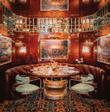
KIMAÏ
B Corp score: 80.0
Freshly minted as a B Corp in August 2023, Kimaï creates fine jewellery from lab-grown diamonds. “We never say we are 100 per cent sustainable,” says co-founder Jessica Warch. “We’re really just trying to do better and take a step forward.”

X+WHY
B Corp score: 98.3
Flexible workspace provider x+why was set up with the intention of becoming a B Corp as quickly as possible. “Rather than tinkering under the bonnet retrospectively, it’s very much a part of our DNA,” says co-founder Phil Nevin.

suppliers. “We were able to take that learning and develop workstreams that invested in these areas.”

As last year’s Natural History Museum gathering demonstrated, there is a sense within the ranks of B Corp companies that they’re part of a larger collective. “With B Corp, we really do feel part of a movement,” says Phil. Aileen agrees: “One of the biggest perks of becoming a B Corp is the connection to the community. It’s an amazing ecosystem of more than 6,000 businesses around the world that are pushing boundaries and doing great work to make business a force for good.”
In recent years, the profile of this community has been gradually shifting, with larger companies – including some that in the past may have drawn criticism for their activities – now joining the fold. Rather than undermining the scheme’s credibility, as some sceptics have claimed, Phil thinks that its embrace by multinationals illustrates B Corp’s power to create change. “Some people might look at big corporations like Nespresso and Danone being certified and wonder about it, but I think it’s actually a wonderful sign that the movement is breaking out beyond the small-scale startup community. No business is perfect, and that’s not what B Corp is about. There is a misunderstanding in all of us, I think, that change strikes like a bolt of lightning on a Thursday afternoon. And of course, it’s not like that at all,” he says. “The only way change happens in this world is iterative – and that is the brilliance of B Corp. It enables businesses to improve iteratively over time.”
B Corp: the whys and wherefores
Phil Nevin, co-founder of x+why
Even before we incorporated x+why in 2018, we knew we wanted it to be a B Corp. That was helpful for a lot of reasons. Because we were doing it while setting up and were using it to structure our affairs rather than tinkering under the bonnet retrospectively, it’s very much a part of our DNA. For example, you score points in the governance section of B Corp if you have an employee stock ownership plan (ESOP), which gives your employees a stake in the business, so we put that in place from day one. This has had an incredible impact on how engaged and enthused our employees are about what we’re doing. It has also influenced our mission when it comes to our members: we are lucky enough to have access to all sorts of businesses of various sizes under our roofs and even if you can
29 — MARYLEBONE JOURNAL / ISSUE NO. 101
THE B LIST
>
SÉZANE
B Corp score: 82.5
New to Marylebone High Street, the Paris-based fashion brand is, says its founder Morgane Sézalory, “guided by a desire to create timeless pieces that respect the planet and its people”. Sézane achieved B Corp status in 2021.

DAYLESFORD
B Corp score: 87.3
Certified for the first time this year, the Daylesford food and farming business is now looking beyond its strong environmental score. “Our focus for the time being is on social impact, particularly in relation to our staff and our supply chain,” says Will Dennis, head of sustainability.

ALLBIRDS

B Corp score: 96.5
Footwear brand Allbirds achieved B Corp status shortly after the company’s foundation in 2016. “We were drawn to B Corp’s in-depth framework and the thoughtfulness with which they make their assessments,” says senior manager of sustainability Aileen Lerch.
have just the smallest influence on people, that’s an opportunity not to be missed. Every new member at x+why has to sign a pledge – a soft pledge – which mirrors the highlevel B Corp ambitions to look after the planet and people as well as the bank balance. There is no draconian evaluation on our part, but we want businesses to think about their purpose before coming under our roof. It’s a call to arms in a way.
The fact that we’re responsible, that we look closely at the supply chain within our buildings, whether that’s green energy or sustainably sourced products for cleaning, is a major reason that businesses choose to become members. Many move because, even if their previous focus was simply profit, they’ve now understood that in today’s world you need to look wider than that. If our members are thinking of going through the B Corp certification process, we offer a workshop series called WhyB, which we host in partnership with B Lab UK. You participate alongside other companies
similar to you, so you’re sharing the experience. You’re paired with a B leader – a consultant who understands the impact assessment deeply – who will help you with your preparations for certification and answer any questions you have. Everyone always has loads!
I founded x+why together with Rupert Dean and Tanya Donald. Rupert is a lawyer, Tanya is a PwCtrained accountant and I’ve been a property developer and also set up an educational charity called Big Change. It’s a nicely rounded founder group. Each of those professions can have an amazing amount of influence. How policy and agreements are worded has a massive impact on how sustainably and ethically things are run, and equally I think accountants really can save the world – because you can’t make and evaluate progress without data.
Back in 2020, we were certified with a score of 98.3. We did well in the environment section because we have focused on building in a sustainable way, and in the governance section,
but we will have dropped points in the last couple of years because we started with fewer than 10 employees and are now up to 10 buildings and have thousands of members, and our points will have fluctuated as we’ve grown. The challenge is how we scale up and stay true to our mission. We are due to recertify next year, and we’re launching our ‘Race to 100’: every employee is able to put their hand up and join a working group whose mission will be to improve the business in a specific area. For example, there will be an environment group looking at environment and an employee group looking at everything that sits under the workers area of B Corp’s certification, such as maternity and paternity leave. They will challenge the leadership team at x+why to undergo a programme of improvement in those areas. It’s super exciting to be on that mission to make the business better.
X+WHY
1 Great Cumberland Place, W1H 7AL
xandwhy.co.uk
30 — MARYLEBONE JOURNAL / ISSUE NO. 101 THE B LIST
THE WAY TO B The B Corps of Marylebone
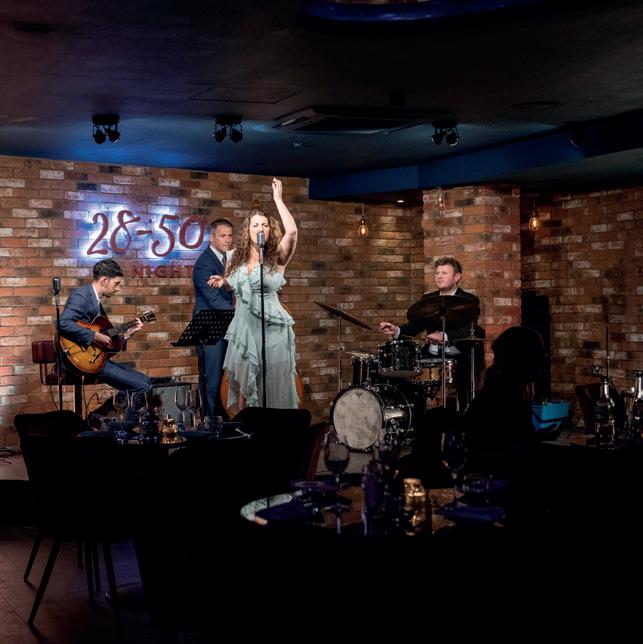





THE DIFFERENCE MAKERS
The Soho Theatre Company was set up in 1968 and located at a number of small venues for the first few years of its life. Then in 1972 it found a little basement space on Riding House Street, which belonged to what was then known as the Polytechnic of Central London, now the University of Westminster. The deal was that the company could use the space, but the name would become the Soho Poly, an amalgamation of Soho Theatre Company and Polytechnic of Central London.
From then until 1990, when the Soho Poly closed its doors, the venue was one of the pioneers of lunchtime theatre, which aimed to be a more democratic, less bourgeois artform. Rather than being like the West End, where you paid a lot of money for tickets and a pre-theatre meal, the performances were something you could attend during your lunch break while eating a sandwich. There was this strong sense that theatre could and should be something ordinary and every day.
Because they were writing for a shorter lunchtime slot – 45 minutes to an hour long rather than two or three hours with an interval – playwrights were motivated to create very arresting plays that would catch your attention immediately and drive through to their conclusion. Then the audience would leave and go back to their day. This lunchtime slot changed audience patterns and also what writers and actors were doing creatively.
Introducing the people behind central London’s vital charities and community organisations: Matthew Morrison, co-creative producer of the newly restored Soho Poly theatre

Interview: Jean-Paul Aubin-Parvu
Portraits: Orlando Gili
Hanif Kureishi and Caryl Churchill both honed their craft at the Soho Poly. Barrie Keeffe, who went on to write The Long Good Friday, had his most significant early plays at the theatre, including SUS, which addressed head-on the racist stop and search laws of the time. The actors Paul Barber and Roger Allam appeared in that. Bob Hoskins was another famous name who was involved there. He wrote and performed his own one-man play during the mid-1970s.
I first heard about the Soho Poly while researching the early history of Soho Theatre. I had a theatrical background as an actor and playwright and worked at the University of Westminster. I knew that the old theatre must be somewhere on the university’s estate. Eventually, in 2012, I found an internal door that opened onto a rickety staircase. I went down into the basement and found an anonymous junk room full of rubbish – nothing theatrical at all. It was hard to believe it, but this had once been a crucible of alternative theatre. That was the point at which I thought, wouldn’t it be amazing if we could bring this space back to life? It has been a decade-long journey to get to where we are today. >
33 — MARYLEBONE JOURNAL / ISSUE NO. 101
THE DIFFERENCE MAKERS
In the early years, we started by doing some pop-up events in the space to try to get momentum into the project. Slowly, the university began to come on board. A new vice chancellor, Peter Bonfield, came in about six years ago. He picked up on our passion for the project and really helped to bring the rest of the university in behind it. He became a real champion for what we’re doing here. Jordan Scammell and Jules Attanayake from the university were also instrumental on the fundraising side, helping us put together internal bids for some of the capital works and raising money from external sponsors, including The Portman Estate.
We were successful in a bid for around £100,000 from the National Lottery Heritage Fund, which provided funding for an oral history and outreach project. We interviewed people who’d been involved in the theatre, including Simon Callow, Hanif Kureishi, Harriet Walter and Phil Davis. We also wrote an education pack for sixth form students about progressive and inclusive theatre, which drew on the Soho Poly’s history as one of the pioneers of all sorts of radical theatre experimentation in the 1970s. And we wanted students to think about all the important things that people should be thinking about today – theatre and neurodiversity, theatre and disability, theatre and ethnic minority participation – by linking those themes to the radical activism of the Soho Poly in its heyday.
Guy Osborn is my fellow co-creative producer at the Soho Poly. He joined the project about seven years ago and we just immediately clicked. Guy has a particular interest in music and has been instrumental in uncovering the wider university’s musical history. All sorts of bands and artists have played across its various campuses over the years including New Order, David Bowie and Jimi Hendrix. Many significant musical events have happened over the university’s life, and before the Soho Poly took over the basement space it had been a little folk music club. Guy has been activating that musical history and thinking about music events for the future. He’s just a fantastic collaborator – we work very closely as a pair to come up with ideas and put it all together.
We put on a lovely event last year with the writer Jon Ronson and a singer called Emma-Lee Moss, who at the time went by the name Emmy the Great. And step by step we built up momentum. The final piece of the jigsaw was
getting a premises license from Westminster City Council earlier this year. In June we had a summer festival with some wonderful events including a reading of a Jackie Kay play called Chiaroscuro, which had originally been performed at the Soho Poly back in 1986. Her play is about queer black women’s experiences during the 1980s, so it was very interesting to relook at those issues with our contemporary perspective. We had several gigs over the course of the week, and a brilliant ‘takeover’ by an amazing organisation called Badge Cafe. We also had 14-year-old kids from an East End school coming in for a drama workshop.
Our aim now is to set up strands of activities that can go on all year round, including poetry events, community workshops and regular gigs. We then plan to curate seasons, where we perhaps have a connecting theme that pulls together a series of disparate events. We’re particularly keen on the idea of bringing different communities together; for example, we might invite a theatre company to come and use the space, but then we’d like them to maybe offer mentorship to some of our university students or run workshops for one of the charities we partner with. We’re building a real sense of exchange, with the theatre becoming a place where people share their expertise, skills and passion. Our mantra is ‘disrupt your everyday’. The idea is to have a spread of events at different times of the day, meaning we can reach different audiences and people can disrupt whatever their daily routine is with something cultural or creative.
It’s been an amazing feeling to see a basement full of junk transformed back into the Soho Poly. We’ve been at it for a long time, so it can be quite emotional when things come together. What’s also interesting is to see how it affects people who were involved in the theatre during its original incarnation – when they come back and see that it still has life. It’s often quite a powerful experience for them, walking down these old steps for the first time in several decades to revisit a venue that was so important to their early careers. It’s been a long journey, and a fairly exhausting one at times, but it’s moments like those that make it all worthwhile.
SOHO POLY
16 Riding House Street, W1W 7DT donate.westminster.ac.uk/donate/soho-poly-theatre
34 — MARYLEBONE JOURNAL / ISSUE NO. 101
THE DIFFERENCE MAKERS

35 — MARYLEBONE JOURNAL / ISSUE NO. 101
THE DIFFERENCE MAKERS
“It’s been an amazing feeling to see a basement full of junk transformed back into the Soho Poly. It can be quite emotional when things come together.”
A CLOSER LOOK
FOOD » 36
STYLE » 42
HOME » 50
WELLBEING » 53
HEALTHCARE » 56
FOOD » 38
FOOD PHILOSOPHY
Ryan Garrick of WatchHouse on ethical sourcing, relentless tasting and testing, and the key to making good coffee at home
STYLE »42
Q&A
Henrietta Rix of RIXO on vintage fashion, LA smoothies and giving up youthful follies to build her brand
HOME » 50
ANATOMY OF A DESIGN
Shelley Simpson of Mud Australia on why her approach to ceramics is about much more than creating beautiful objects
Q&A:
ALEXANDRA PETITMENTZELOPOULOS
The owner of Clarette on empowering staff, disdaining wine snobbery and ignoring the ‘rules’ of wine pairing
Interview: Viel Richardson
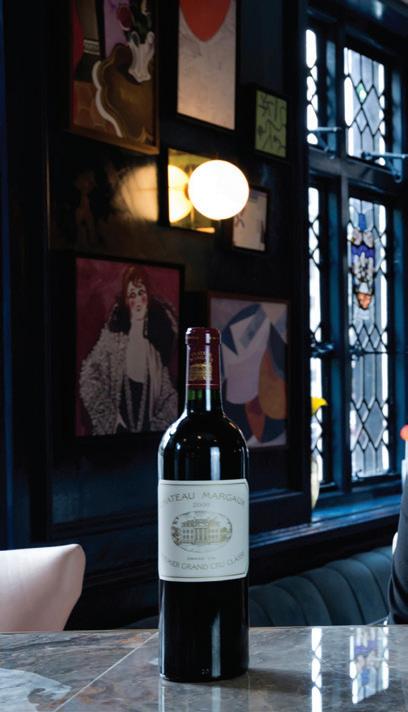
36 — MARYLEBONE JOURNAL / ISSUE NO. 101
A CLOSER LOOK FOOD
In 2017, when you opened Clarette alongside the restaurateur Natsuko Perromat du Marais, what was your vision for the venture?
There was this feeling that wine, especially Bordeaux wine, was a bit old school, a bit stiff. I wanted to show people that wine could be a relaxed, laid-back drink. So from the beginning I saw Clarette as a laidback place where you could have a really nice glass of wine and not be stressed about it. I wanted to show that wine, even at that level of quality, can be a relaxing experience. I didn’t want to open something too fancy, because that can be intimidating to many people, and that’s why Clarette has a very relaxed and chilled feel about it.
You moved from small plates to a full menu. Why was that?
At the beginning I was there every night and could see people ordering plate after plate. I very quickly realised that our food offering was not really working. We would get these tables of big guys ordering several bottles of wine and you could see that they wanted more substantial food to go with their wine. People were treating us more like a restaurant, even though we hadn’t intended to be one. Quite soon after opening we hired a chef and developed a full menu.
What is your view on wine and food pairing?
Of course, we create some dishes that work well with particular wines. But we also believe that a lot of what you hear about wine pairings is just somebody’s opinion. It’s not mandatory that red wine goes with meat or cheese. Often people will choose their dishes for the evening and then ask the team to provide wine suggestions for each course. Here, we take our lead from the customer. If they want to stay with the classic pairings, we can do that, and if they want to be more adventurous, we can do that as well. So, while pairing food and wine is a wonderful experience that can

37 — MARYLEBONE JOURNAL / ISSUE NO. 101 A CLOSER LOOK FOOD >
improve both when done well, you don’t have to be too rigid about it.
Has Clarette’s wine list evolved, or has it stayed fairly stable?
The idea behind the wine list has remained unchanged. When we opened, I decided to only serve 50 per cent French wines and the rest from around the world. London is an international city and there are great wines from all over the world that I wanted to showcase. We look at the trends and judge what we buy accordingly. As an example, English sparkling wine has become extremely popular in the last few years. There is also assyrtiko from Santorini in Greece, which is a wonderful white wine. We also want to showcase some less well-known French wines from the other regions of France. There is so much incredible wine that deserves a wider audience.
So, it’s about keeping an open mind?
Yes. We have the classics, of course, from France, Italy and Spain, and these are the bestsellers, but you have to be open minded. We try to have wines from places like Hungary or parts of France like Jura which are less known. Places that refuse to sell New World wines or wines from new regions is something I don’t understand. It doesn’t take away anything from the classics like Bordeaux, Burgundy or those amazing regions that have centuries of winemaking knowledge. These places should feel secure about their products – they have built these amazing environments that nobody will be able to recreate for centuries. Some of the new winemakers are working extremely hard and producing some very good wine. You have to judge them against accepted standards, but if they are good, why not give them a chance to be seen?
How is your wine list curated?
When we opened, I helped put the wine list in place, but then I gradually stepped back, as I had always
intended to do. Now my main role is to set the framework for the wine list. This includes things like wine regions we want to buy from, any seasonality or trends we want to cover and the different price points. Then I leave the Clarette team to curate the list itself. That is very important. It empowers the staff, gives them a sense of pride when they see people enjoying their wine, because curating our list is not easy. I do check in regularly to see how it’s looking, but it is their wine list.
Your family owns France’s legendary Château Margaux wine
estate. So, has wine always been a big part of your life?
Because I was born into it, wine has always been special to me. People ask if I started drinking super early. Of course, the answer is no, I was not drinking when I was five. Sure, I was allowed to taste small amounts of different wines as part of my education from a young age, but that is very different to drinking! I was taught that wine is an amazing product; not a fancy one, not a snobbish one, not one reserved for the elites. It is just an amazing product that should be open to everyone.
FOOD PHILOSOPHY
WATCHHOUSE
Ryan Garrick, head of coffee at WatchHouse, on ethical sourcing, relentless tasting and testing, and the key to making good coffee at home
Interview: Ellie Costigan

I oversee the whole coffee journey, from seed to cup. At farm level, selecting the coffee, all the way down to how it’s experienced by the customer.
We want to work with a different kind of supplier – ones that are unique to WatchHouse. Normally that means they’re a smaller exporter, are local to the country they’re selling from, and understand the social and environmental elements of that place.
You cannot make good coffee from bad beans: the raw material is critical. But you can ruin good coffee, so the roasting and brewing processes are also essential. If you don’t have the right people and equipment, it can all be for nothing.
We assess each batch of beans via a process called cupping.
38 — MARYLEBONE JOURNAL / ISSUE NO. 101
A CLOSER LOOK FOOD
Is there an aspect of the world of wine that you would like to see change?
The wine world should be much more approachable, a bit more chilled out. Of course, I respect our traditional way of talking about the wine because it’s such a fascinating product, and we have to maintain high standards. But at the same time, I hate the expression ‘wine snob’, which some people wear like a badge, because wine can be very high end. Wine is an amazing product but it’s one that should be enjoyed, shared with your loved ones, it should bring people together not
be hidden behind a wall of snobbery. I think that’s changing. There’s a new generation opening restaurants with a focus on making wine more approachable, but there is still a way to go. Clarette is my little way of contributing to this movement, and I’m very proud of it.
Why did you choose to open in Marylebone?

I wanted an area with a sophisticated but relaxed vibe. It has this wonderful village atmosphere with great shops, but it’s also a residential area which really adds to the feel of the place. Whenever we thought of a quality we
wanted from the area we opened in, Marylebone was a perfect fit.

What would you like a Clarette customer to feel as they’re leaving? The first word that springs to mind is ‘happy’. Simply happy. I would like them to leave with an increased knowledge of wine, to have enjoyed their time with us, their interaction with the team and the environment. But the most important is for them to leave feeling happy.
CLARETTE 44 Blandford Street, W1U 7HS clarettelondon.com
We get a lot of coffees on the table, taste 20 to 30 samples, and think about whether they match our criteria.
The equipment you have in the bar is very important if you’re going to maximise flavour. There’s a huge range in the quality of grinders and machines. In London, you’re working at high volume, so you need to be able to execute the required steps at a high pace – and maintain your machines. The skill level of the staff can make the difference between the customer getting a 7/10 or a 10/10 cup of coffee.
At the moment, there aren’t many great solutions for things like instant coffee, but I think that will change. They have a place and can be good – if you find yourself on an aeroplane,
you can get drip bags that can be good. It’s a small coffee filter bag, which you just add water to – a bit like a tea bag. But the processing of it means it’s not ever going to be quite as good.
Because we buy in micro lots, from producers who might only produce a few bags of coffee, we’re really purchasing directly from them. Even if the payment goes through someone else, they’re close to that price agreement. But the ethics of coffee buying doesn’t end with the farmer. They’ll have employees who pick and process the coffee, so we will be looking at the fairness of those practises too.
I often travel to the places our coffee is grown – usually Colombia, Peru, Costa Rica and Ethiopia. We will visit 80 to 90
per cent of our suppliers before taking them on.
If you buy good coffee to use at home, you’ll need a grinder. All the great aromas and flavours of coffee – and it’s the aromas that make up the flavour – are lost very quickly when you break the bean, so invest in a grinder and do it yourself.
Anything with a filter paper will be better than something without, like a cafetiere. It just provides a better cup of coffee.
We have our own roastery and work in 20kg batches of coffee. Everything is controlled here and tested here. Each coffee will be treated differently, depending on the bean and on the ultimate application. Small changes can make a big difference – you’re talking just a couple of degrees or seconds one way or the other.

The more knowledge you have in the team, the more you can enrich the customer’s experience – and their appreciation for the coffee. On the bar, our team understand that coffee is changing all the time. You can’t just take a prescribed recipe and do it the same way every day, you have to do a lot of adjusting and tasting. That requires real sensory skill.
If I’m in a coffee shop, generally I’ll have an espresso. Making a good espresso at home isn’t worth the investment. At home, I would go more for a filter coffee. I’m going to grind and brew a single filter portion. That’s the way to get the most value.
WATCHHOUSE
32-34 New Cavendish Street, W1G 8UE watchhouse.com
39 — MARYLEBONE JOURNAL / ISSUE NO. 101 A CLOSER LOOK FOOD
MOLE VERDE
Adriana Cavita, head chef of Cavita, on one of her signature dishes
In a nutshell
This dish is a whole spatchcocked herb-fed chicken, marinated in olive oil, garlic, onion and green herbs then grilled and served with a green mole, which is a very traditional sauce from a central area of Mexico. It’s a very popular dish, particularly at parties and big gatherings.
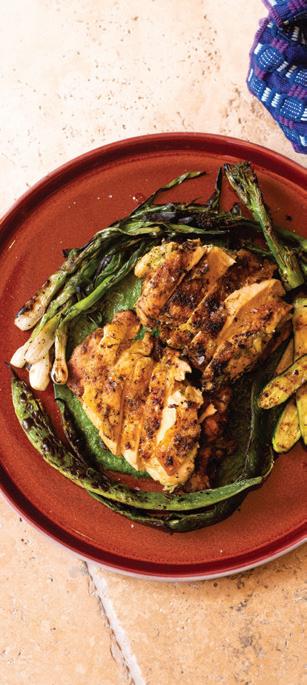
The inspiration
Whenever my family gather together, this is the dish we have, served with rice and homemade tortillas. My aunt would always make the sauce, and traditionally in Mexico we would boil the chicken – but I love cooking with charcoal, because it imparts a smoky flavour to the dish. It’s a really special dish for me; it reminds me of my family and gives me a feeling of celebration. Every country, every family, has a dish like that, and I wanted to share ours with the UK.
The technique
Much of the technique is in the sauce. It’s a fresh herb sauce, and it’s completely unique. It requires the perfect toasted pumpkin seeds, which add a bit of nuttiness, the perfect proportion of parsley, garlic, onion and coriander. In Mexico we use a volcanic rock mill to make the moles, as well as to grind the corn for the tortillas, which we make on site. I also marinade the chicken at least a day in advance, so all the flavours go inside. It’s very important that the heat is right on the grill, otherwise it can be very bitter. So there are different techniques, adding different layers of flavour. We serve it with grilled vegetables, which are a bit more simple to prepare, but you still need to pay attention to the heat.
The secret
I always source quality, freerange chicken, and I think cooking over charcoal brings an extra layer of flavour. It’s a simple dish, and there is beauty in simplicity, but the simplest things aren’t always the easiest. I think it’s the combination of everything.
CAVITA
56-60 Wigmore Street, W1U 2RZ cavitarestaurant.com
40 — MARYLEBONE JOURNAL / ISSUE NO. 101 A CLOSER LOOK FOOD ANATOMY OF A DISH
A GLASS APART
Gregorio Soriente, bar manager at The Zetter Townhouse Marylebone on the thinking behind a rather unusual cocktail
Interview: Viel Richardson
Image: Lateef Photography
This cocktail perfectly represents the concept behind our current drinks menu. The idea is to look at a drink without any preconceptions. This is why I called it Cocktail No.2. We are taking the classic cocktails and interpreting them in a way that takes you right out of your comfort zone, but in a positive way. By doing this I want to open customers’ minds to new tastes, to new possibilities.
Each cocktail is linked to a specially commissioned image that represents its spirit. Looking at the artwork for this, you imagine a liquid artichoke. Artichoke is not an ingredient from the mainstream of drinks! The flavour profile of the cocktail is like a bellini, which brings to mind peach and prosecco. It’s really fruity, to remind you of the peach, and has the mouthfeel of a bellini – but the artichoke flavour is there!
It is quite a process to get an artichoke to a state where you

can use it in this cocktail. The challenge was to recreate the full artichoke flavour after breaking down the vegetable into a liquid form. First we cook and blend the artichoke then strain and blend it again. The idea is to extract the pure juice. We add some lemon, which brings acidity, cures the artichoke and preserves some of the colour. We then add some sugar, whisky and Bianco di Ampeleia, an Italian orange wine which enhances the metallic flavour of the artichoke. After that we carbonate the liquid to bring some of the fizz you’d get from prosecco.
The idea for the drink came during a chat between bartenders. I was at the Artesian bar at the Langham hotel, talking to the head bartender Giulia Cuccurullo. I brought up the idea of an artichoke bellini as a joke. But the idea stuck with me. I thought, I have to see if I can make this work. It took a very long time, but I like

the final drink – it plays with the customer’s head in the best possible way.
What we’re trying to do with drinks like this is build an experience. We want to create something that will stick in the mind of the customer, something that will not just disappear into the background of their memories. But it cannot be some kind of gimmick; it must be an honest creation. When we design a cocktail, the aim is for the guest to taste everything in it. I don’t want to list ingredients that catch the eye but which you cannot taste in the drink. You will get the flavour of the artichoke when you drink this cocktail. It’s not for everyone but those who do like it really love it and come back for more. For me, that is the real mark of success.
28-30 Seymour Street, W1H 7JB thezetter.com
THE ZETTER TOWNHOUSE MARYLEBONE
41 — MARYLEBONE JOURNAL / ISSUE NO. 101 A CLOSER LOOK FOOD

42 — MARYLEBONE JOURNAL / ISSUE NO. 101 A CLOSER LOOK STYLE
Q&A: HENRIETTA RIX
The co-founder of RIXO on vintage fashion, LA smoothies and giving up youthful follies to build her brand
Interview: Emily Jupp
RIXO began as an idea shared by you and your co-founder Orlagh McCloskey in your living room in 2015, after you’d both attended London College of Fashion and then been buyers for ASOS. You quit your jobs in February 2015 to set up your own brand. What was that like?
It’s been a really tough journey. Orlagh and I gave all of our 20s to RIXO. We were working from an Ikea table for three years until 3am and then up again at seven. We missed Christmases, christenings, birthdays... It has gotten easier, but even now we’re extremely busy. My family are in Manchester and I work in London for part of the week, so I miss out on bedtimes with my children. The thing that motivates us is when we get customers telling us how much they love RIXO and that they wear it at important events. That’s the most amazing feeling –and you remember there’s a reason for doing this. It’s so much more than just a dress.
That’s an impressive work ethic, especially for someone so young! Well, I had my time drinking and having a great time when I was young, and then at university, but after that, it was full-on RIXO mode.
Could you have imagined back then in 2015 what RIXO would become?
We were clear on the proposition, the brand, the price point and the product, but we never had an end goal. We always want more for RIXO. When Net-a-Porter started stocking us early on, we celebrated it, but we didn’t stop there. We’ve just come back from LA and there is so much potential in LA, New York and Texas – there is more still to conquer!
What was the best part of that LA trip?
There’s a new supermarket called Erewhon [pronounced ‘air-one’] – it does 20-dollar smoothies. Everyone was raving about them and we were
such suckers, such typical tourists, so we did try a smoothie and it was very good! We did a late-night hike and then went there. Everyone was sitting outside at 10 in the evening and there was some great people-watching to be done.
What would your advice be for anyone wanting to start a business? University is really expensive now, so I’d say to anyone to get work experience first. Our most valuable year at uni was the year in industry, so grasp that with both hands. You also have to be so passionate about your idea to be able to drive it forward, because there will be really tough days.
Do you have a career highlight so far?
Probably opening the flagship store on the King’s Road. We dreamt of opening a flagship store from the very early days, so to see it come to life was really special, it’s amazing to see the full RIXO collection under one roof for the first time. Sustainability was a big focus throughout, with many items either recycled, dead-stock or from natural sources, like the Palladian terrazzo floor made from recycled leftover stone and antique furniture.
The RIXO style is quite bohemian and inspired by your travels – like the recent collection, Postcards from Goa, inspired by Orlagh’s trip to the Fontainhas, Goa’s Latin Quarter. The Marylebone style is also quite cosmopolitan and eclectic. Is that why you decided to launch a store there?
It’s a high street we’ve always admired, with a beautiful community vibe that chimes with RIXO. The Marylebone customers have great style and they travel a lot and get inspired, rather than being trendled, so RIXO fits with their lifestyle.
What’s the oldest dress in your own wardrobe?
I’ve got a gorgeous 1920s silk bias-cut
43 — MARYLEBONE JOURNAL / ISSUE NO. 101 A CLOSER LOOK STYLE >
dress. It was a second-hand dress of my mum’s – and I’ve had it since I was 16. You have those pieces, don’t you, that you wear over and over again. I love how good quality fabric gets better with time. Silk gets so soft – the handfeel of it after a couple of years, is lovely.
Speaking of which, you’re about to launch True Vintage, a line of curated vintage items online... It’s a collection of 30 pieces, curated by us. We sourced them from Italy. We’ve got Pucci jackets, YSL summer wedges and a Biba minidress and some gorgeous stuff with no label at all. We always knew we’d love to launch vintage clothes online. When we launched our first pop-up shop in 2015, it was half vintage, half RIXO. It is just that it’s only now we’ve reached a point where we can sell vintage online, because the process is quite different. Each garment needs dry cleaning, we tell the story around it, it needs individual measurements
and needs to be photographed to sell once, not multiple times, so it’s very different to putting a RIXO dress online. So True Vintage is sustainable second-hand fashion but it’s very much part of our brand.
I noticed on your Instagram there are lots of comments asking where your outfit is from and you often say it’s vintage.
Half my wardrobe is vintage items, the other half is RIXO. But we’ve done a few vintage-inspired gold belts and our customers love those, because they were always commenting on them.
RIXO is inspired by your’s and Orlagh’s mutual love of vintage fashion, so your dresses are timeless and designed to last. How much of your work is inspired by conversations about sustainability?
It’s part of our brand and what we believe in, rather than being a marketing tool. We don’t over-produce, we don’t make things intending to sell some at a discount, we try to hit full-price sales. That does sometimes annoy customers because then pieces sell-out, but that also keeps it really special.
BRYCELAND’S & C0
Ben Chamberlain, store manager at Bryceland’s & Co, on the savviness of London, the US menswear golden age, and the joy of dressing up just for the sake of it
Interview: Ellie Costigan
London is such a melting pot. There are so many brands and styles, and so many different subcultures. It means the London audience is a little bit savvier – they want to be impressed – which makes it a more difficult market than for our Hong Kong and Tokyo stores. The fabric of the fashion society is a little bit more engraved here.
We’ve got some house styles, which we produce in a number of fabrics, but we also offer a made-to-measure service. This means we can satisfy the customer’s desires, but within certain block patterns. Allowing the customer to have something made for them in a fabric which they’ve chosen is a lovely offering.
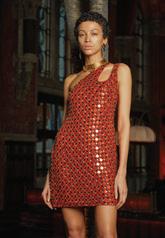

Our main influence is that golden era of menswear, from
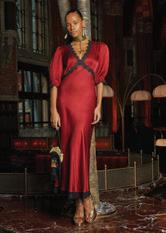
44 — MARYLEBONE JOURNAL / ISSUE NO. 101
A CLOSER LOOK STYLE
STYLE PHILOSOPHY
Do you have a favourite RIXO dress? The Evie dress, named after my first niece. She was probably one at the time and she’s eight or nine now. We name all our dresses after individuals. It used to be friends but now there are too many dresses, so we’re naming them after Spanish islands or something like that.
Is there going to be an Emily dress? We must have an Emily dress already. I’m sure we do!
I heard you designed your own wedding dress and then altered it once it was made?
That sounds a bit dramatic. Because I’d had a baby, I didn’t start making my dress until seven weeks before the wedding. It was based on one of my mum’s vintage dresses. I tried it on and the high neck wasn’t working, I just thought, this is awful and so I got a pair of scissors and chopped the front! As soon as it had a v-neck it changed the dress completely.
Do you get a kick out of seeing celebrity fans like Margot Robbie wearing your dresses?
We love seeing all of our customers in our pieces as much as we love
seeing celebrities in the collections. It’s so lovely to see how everyone styles the pieces differently for all occasions.
And finally, what should I wear to deal with London’s constantly changing weather and still look good?
Our leopard-print Kelly skirt. You can wear it with a chunky knit and boots in winter or a little crop top in summer. I wear it all year round.
RIXO 27 Marylebone High Street, W1U 4AD rixolondon.com
person doing this and I really align with you, let’s see what we can do.” Another partner is Cody Wellema, who makes the most beautiful handfinished hats with animal pelts. Our partners are artisans, craftspeople. It’s them doing it, not a team of people in a workshop.
the 1920s up until the 1960s or so. A lot of that was led by America and the superpower it became after the second world war, with its young, can-do attitude, the birth of youth culture and the changing and embracing of a blue-collar aesthetic.
Our house suit is a lovely mix between American, English and Italian suiting. It isn’t as structured as a British suit – it’s a little bit softer. A drop shoulder gives it a loucheness, more reflective of Italian suiting, which is a lighter-weight fabric, half lined and has a softer shoulder but maybe with a bit of padding. It also draws on the American style, where you get a bit more of a sack suit – that easy-to-wear Ivy League block shape. It’s a garment to live and move in, rather than just go to work in.
A big ethos of the brand is a high-low aesthetic: pairing something that has an element of elegance to it with something that brings it back down to earth. A heavily worn leather jacket with a beautifully cut pair of high waisted trousers, for example. It gives it a readiness, an earthiness, and makes it a little bit more relevant and playful.


One of the founders, Ethan Newton, has worked in menswear since he was 17. He has such a breadth of knowledge and has worked for multiple brands – in fact, co-founder Kenji Cheung was a customer when Ethan worked at The Armoury – but he never quite felt that anything was ticking all the boxes for him. It’s one of the things I love about the brand. Ethan will say:
“I make clothing for Kenji. I make clothing for me. It’s clothing we think is totally wearable.”
When you’re working from home, as more people are doing these days, you can wear whatever you want. When you’re not getting dressed every day for work, it’s more enjoyable when you do get dressed and go out. You can look good for the sake of looking good – wear a suit for no other reason than just, I want to wear a suit today.
If we approach a new partner, there will either be a connection there already, or they’re producing something we admire. For example, Ethan met Mike French of Red Rabbit, who produces jewellery for us, while at a trunk show in Japan. He said: “You’re the best
We can tailor our house style suit however you like – double breasted, single breasted with two buttons. The house trouser, the Winston, is a really beautiful high-waisted trouser with a nice straight leg that sits perfectly between not too slim and not too wide. We can change that completely to the customer’s desires, with forward-facing pleats, rear-facing pleats, a wider leg, a slightly more tapered leg. It’s about working with that customer, giving them the opportunity to be a bit more adventurous or to find something that aligns with their style.
Bryceland’s is still quite a small brand. We have three stores and I know everyone who works at every single shop. It’s a very grassroots company, where everyone’s in communication all the time. There’s a constant fizzing of ideas.

BRYCELAND’S & CO
48 Chiltern Street, W1U 7QS
brycelandsco.co.uk
45 — MARYLEBONE JOURNAL / ISSUE NO. 101
A CLOSER LOOK STYLE
The Workers Club

Newly arrived on Chiltern Street, The Workers Club (TWC) was founded in 2015 by married couple Adam and Charlotte Cameron and nurtured in rural Oxfordshire before making its big move to the heart of London. The brand, whose name, aesthetic and ethos draw inspiration from the 1920s constructivist movement and its advocacy for collaborative workspaces, is all about quality fabric, artful construction and timeless design. The Camerons have spent years developing fruitful partnerships with specialist suppliers and manufacturers, from the denim makers of Okayama, Japan to the family-run cloth mills of Scotland. THE
AUTUMN JACKETS
There are two consolation prizes that come with the autumn onset of dark evenings and chilly air: one is jacket potatoes, and the second, simply, jackets. One embraces cheese and baked beans, the second wraps snugly around oneself. Here are three jackets promising style as well as substantial warmth – which is more than can be said for the humble potato. Wrap up –and smile as if butter wouldn’t melt.

46 — MARYLEBONE JOURNAL / ISSUE NO. 101 A CLOSER LOOK STYLE
THREE OF THE BEST NEW ARRIVAL
NEW
WORKERS CLUB 58 Chiltern Street, W1U 7QZ theworkersclub.co.uk
3. 2. 1.
Everyone needs a velvet jacket in their life, even – perhaps particularly – those who are ‘not a velvet jacket person’. Like smart heels and pearl necklaces, velvet jackets have the power to transform any outfit from mundane to sublime. Bella Freud’s Saint James number is a case in point, with wide lapels and patch pockets all rendered in a deep navy plush velvet that will go with everything and make it all better.
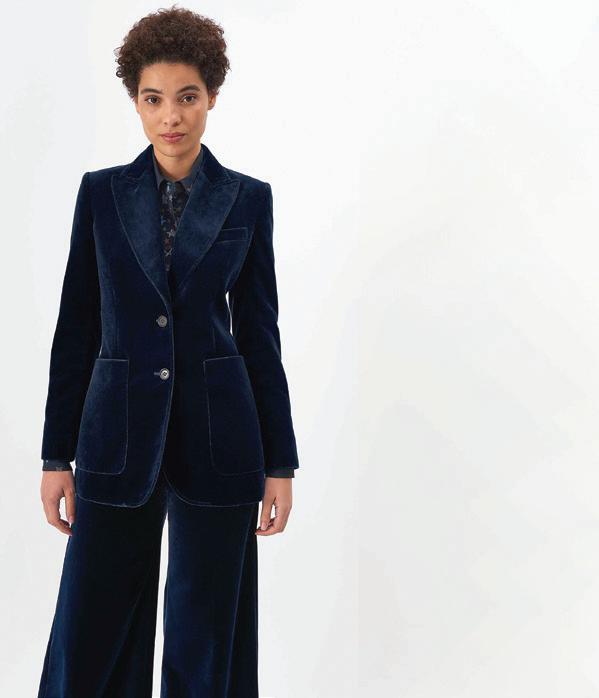
Much like the sunshine in September, this jacket is a halfway house: neither too long nor too short, too hot nor too breezy, too casual nor too smart. Even its fabric is mercurial: a planet-friendly blend of recycled materials, wool and insulating alpaca, all boasting a herringbone pattern that is both bang on trend and for all time.
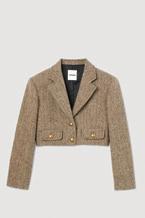
Fun, vibrant, reversible and soft – this is a jacket in which to pretend it’s still summer while dressing for autumn. There are pockets for practicality, plus both a zip and a cord tie – the 2023 equivalent of belt and braces – for extra warmth. If the sun does deign to show up, turn it inside out to bare the white side and keep cool; otherwise retreat into its red embrace and warm yourself on the compliments that pour fourth.

47 — MARYLEBONE JOURNAL / ISSUE NO. 101
1. VELVET SAINT JAMES JACKET BELLA FREUD, £875 bellafreud.com
2. XIRENA SUTTON QUILT JACKET KJ’S LAUNDRY, £410 kjslaundry.com
A CLOSER LOOK STYLE
3. STRUCTURED CROPPED JACKET SANDRO, £389 uk.sandro-paris.com
AUTUMN MENSWEAR

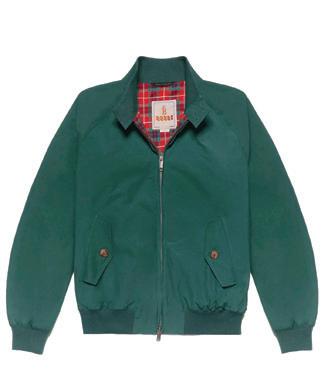





THE EDIT

48 — MARYLEBONE JOURNAL / ISSUE NO. 101
A CLOSER LOOK STYLE
THE LOOK
DOUBLE PLEAT CORDUROY TROUSER SUNSPEL, £245 sunspel.com
HERRINGBONE SOCKS SIRPLUS, £12 sirplus.co.uk
EASY PIQUE POLO GREY FLANNEL, £125 greyflannel.co.uk
MEN’S CASHMERE WRISTWARMERS BRORA, £65 broraonline.com
BARACUTA G9 JACKET JOHN SIMONS, £340 johnsimons.co.uk
CHUNKY KNIT CASHMERE BEANIE LUCA FALONI, £110 lucafaloni.com
DUFOUR SUEDE CHUKKA BOOT TRUNK, £265 trunkclothiers.com
STRIKING A CORD
Olivia Francis of Hamilton + Hare on a corduroy combo that will add a shimmer to the darkening evenings
People often think of London as a drab place in the colder months, but as the nights become longer London’s palette becomes deeper and more alluring, from the warm glow emanating from pub windows to the subtle shades of the skyline after dark. That idea is at the heart of our new items this season.
The centrepiece of the collection is our signature Chiltern overshirt and trouser, named after the Marylebone street we call home. Both pieces are made from corduroy. Aside from being a quintessentially British style, corduroy’s ridges are a wonderful vehicle for colour. The fabric becomes a sea of subtly interchanging tones, from midnight blue to ink black, depending on how the light falls.
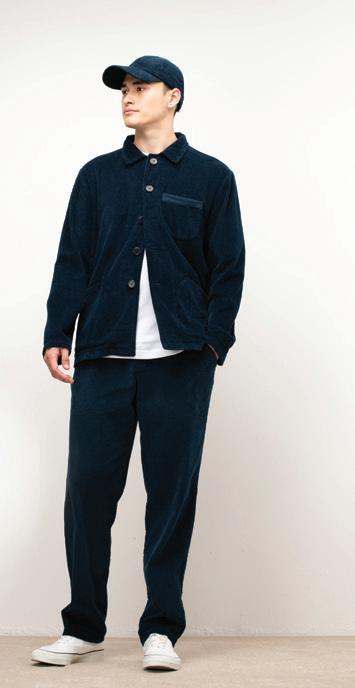
The collection also includes gate green sweats, brushed cotton boxer shorts, chocolate brown t-shirts and orange striped pyjamas, all made in small quantities from sustainably sourced natural fabrics. They’re versatile pieces made for walks in the park, dinners out, evenings in and the new working day – unexpected twists on staple items that become wardrobe favourites, bringing a little bit of comfort and joy with every wear.
HAMILTON + HARE 39 Chiltern Street, W1U 7PP hamiltonandhare.com
49 — MARYLEBONE JOURNAL / ISSUE NO. 101
A CLOSER
LOOK STYLE
ANATOMY OF A DESIGN
PEBBLE BOWL
Shelley Simpson of Mud Australia on why her approach to ceramics is about much more than creating beautiful objects

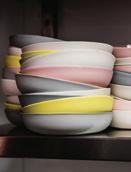
Interview: Viel Richardson
Requirement
In the early days of Mud Australia, when my children were small, we had a tiny dining table that we all sat around for dinner. I didn’t want to keep going to and from the kitchen as the meal progressed, so I created a series of pieces that sat nicely together and held all the elements of a meal. Our Pebble Bowl Large really sums up what we aim for. It can serve as the family fruit bowl or a serving dish, but you can also roast a chicken in it. Then it can go into the dishwasher and straight back into the cupboard. Everything we make has to be functional, look lovely and fit on the dinner table. I have a bigger table now, but that core idea of utility has never changed.
Inspiration
Inspiration can come from many places. For example, a chef we worked with called Danielle Alvarez recently asked why we didn’t have lids on our baking dishes. Lids are tricky because you can’t get a great seal with porcelain – the lid sits on the top, which makes it more liable to drop and break – but I knew in my heart that without a lid the physical form wasn’t quite right. With a new design, there will generally be a few points that need to connect. Ideas will mull around in my head until I have a clear sense of the form. By the time I pick up a pencil and start sketching, I’m halfway there. Once I’m happy with the design, I hand the drawing over to a wonderful ceramicist called
any point in this process, while you can repair the shape, the dent may reappear during firing, so you need to have an extremely skilled touch. The pieces are then fired for 24 hours. The porcelain is vitrified during firing, which gives it a lovely stone-like finish that gets smoother the more it is used.
Materials
We buy our clay from Limoges in France. Limoges porcelain is fantastically durable as well as beautiful. If you drop one of our pieces on a concrete floor, it will break, but otherwise they’re very tough. But it’s tricky material to work with – you need to judge the viscosity of the slip and how much air and moisture is in the clay. When it’s ready to be fired, how you then manage the kiln is vital. A lot can go wrong. There is a reason why ceramicists around the world place kiln god figurines on their kilns for good luck.
Philosophy
Somchai Charoen, who I’ve been working with for over 20 years, who creates the moulds we use. Somchai and I then work on the prototypes together to lock in the final design.
Process
It’s a complex process as each piece is cast in one or more moulds and then hand finished. First, we dilute the clay to make ‘slip’, a liquid form of clay. If we’re colouring the final piece, this is when the pigment is added. The slip is then poured into the mould, which is an extremely delicate process, and left to dry. Once the piece has hardened enough to be removed it’s left for at least another 24 hours to dry out enough to be worked. Our craftspeople then trim off any rough edges and fine-tune each piece. The glaze is brushed onto the inside and the piece left to sit for five days. Porcelain has a memory. If you dent the clay at
Early in the business, I was helped massively by a lovely Indigenous man named Greg Weatherby. He would come into my studio, sit down and paint designs on my pots and take them away. It was not a money-making venture for me – I was just happy for him to come in. He helped me find my first big studio space when I was struggling to keep up with demand. The connection with Indigenous Australians is one I never want to lose. We now work with an arts group called the APY Art Centre Collective, a group of 10 Indigenous-owned and governed arts enterprises. Every year we invite some Indigenous artists to paint their designs on our pieces in the same way Greg did all those years ago. I think this reflects the main guiding philosophy of Mud Australia: respect. Respect for those who came before us, for those we deal with today and for the environment we all depend on. We make nice things, for nice people, in nice places. And we try to tread lightly across the landscape as we do so.
MUD AUSTRALIA
61 Marylebone Lane, W1U 2PA
mudaustralia.com
50 — MARYLEBONE JOURNAL / ISSUE NO. 101 A CLOSER LOOK HOME
OCCASIONAL CHAIRS





THE EDIT
51 — MARYLEBONE JOURNAL / ISSUE NO. 101 A CLOSER LOOK HOME
MODERN FARMHOUSE OCCASIONAL CHAIR ANOTHER COUNTRY, £1,945 anothercountry.com
FLORENCE CHAIR DESIGNERS GUILD, £1,050 designersguild.com
SINGLE SEAT CHAIR VITSŒ, £3,545 vitsoe.com
CHANDIGARH TWIST CHAIR EVOKE LONDON, £1,500 evokelondon.com
CARL HANSEN & SØN CH07 SHELL LOUNGE CHAIR THE CONRAN SHOP, £2,949 conranshop.co.uk
52 — MARYLEBONE JOURNAL / ISSUE NO. 101
SOLITARY CONFINEMENT
Bruce Fogle of London Vet Clinic on tackling the separation anxiety of dogs bought in lockdown and unconditioned to being alone
In 2020, both here in the heart of London and in the rest of the UK, we went on a pet-buying spree. In 2019 the average cost of buying a dog had been £888 but by the end of 2020 it had reached £1,912. Even so, we just kept on buying. By the end of 2021 a dog cost on average £2,080.
Last year, vet clinics like mine were as busy as ever, but for a while at least pet rescue centres weren’t. I’m president of the RSPCA Sussex West Animal Welfare Centre (known as Mount Noddy) and we knew that this was, in fact, the calm before the flood. In 2022 people were giving up their lockdown dogs, but not to rescue centres. Having paid thousands of pounds to buy a dog, people hoped to recoup some of that by putting their pets up for resale online, at reduced rates. As a result, the price of dogs fell by over 30 per cent last year. Having gone through two homes, these are now being handed in at Mount Noddy.
But why are they being rehomed? Are there only economic reasons or is anything else happening? When times are tough, having an extra mouth to feed can be the straw that breaks
you. That’s why pet food is stocked in many food banks. But there’s another more subtle reason people are giving up their dogs and I’m seeing this problem at the London Vet Clinic in the young dogs that were acquired during the two years of the Covid pandemic and raised in homes where people were around all day every day.
Being surrounded by a human pack was at the core of these dogs’ early learning. But when we returned to our previous ways – going to work, visiting friends, taking holidays – some of these pets couldn’t cope. They showed their anxiety by barking incessantly, chewing furniture, redecorating the kitchen or messing in the house. Many people found this overwhelming and relinquished their dogs to rescue centres as a result. Dogs acquired by my clients have been luckier, if only because their carers are usually financially secure. These people come to us asking how their dogs can be helped.
My colleague Dr Natalia Bewick, as well as being an experienced vet, has a master’s degree in clinical animal behaviour. She only sees clinical behaviour problems, in person at the
clinic on York Street or by video link, in dogs and cats. As far as I’m aware, we’re the only primary care vet clinic in the UK with someone with Natalia’s qualifications.

Jemima is a typical challenge. Young. Well loved. Well fed. Well exercised. Lots of chew toys, tug toys, food puzzles. No medical concerns. No underdiagnosed pain. Good bowels. A great girl living a great life. Except that when the front door closes and she’s home alone she howls like the Baskerville hound until a member of her family returns. The home security camera showed that as well as barking incessantly she paced non-stop. This was a very distressed young terrier.
Before Natalia meets a patient she asks the family to complete a very extensive questionnaire on our website. Then the intervention begins. It can be time consuming and consequently expensive but is almost always beneficial.
In Jemima’s instance the way to instantly stop her separation anxiety behaviour, while her family geared up to understand how to change her behaviour when she was home alone, was for her to go temporarily to dog daycare. Her human family learned how to read her body language more accurately and how to desensitise her to the front door closing.
This is the 50th anniversary of my setting up the London Vet Clinic, originally on Seymour Street. Back in the 1970s I treated mostly road traffic accidents and infectious diseases. Today we treat the conditions of aging, and quite unexpectedly, behaviour challenges in both cats and dogs. Counter-conditioning or desensitising a dog or cat to overcome a behaviour challenge takes time and dedication from everyone. Improving or saving a life through a behaviour intervention isn’t as dramatic or as instantly rewarding as doing so with medicine or surgery but the end result is just as important.
LONDON VET CLINIC 86 York Street, W1H 1QS londonvetclinic.co.uk
53 — MARYLEBONE JOURNAL / ISSUE NO. 101 A CLOSER LOOK WELLBEING
HAIR, SKIN + NAILS SUPPLEMENT ANATOME, £28 anatome.co

NAIL CARE
THE EDIT
KURE BAZAAR DETOX OIL NAIL POLISH REMOVER JOHN BELL & CROYDEN, £19 johnbellcroyden.co.uk

CRYSTAL NAIL FILE MARGARET DABBS, £16 margaretdabbs.co.uk
WOODEN NAIL BRUSH LABOUR AND WAIT, £15 labourandwait.co.uk

NAILBERRY SIMPLICITY OXYGENATED NAIL LACQUER SPACE NK, £16 spacenk.com
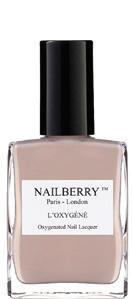
HONEYSUCKLE MOISTURISING HAND CREAM FRESH, £16 fresh.com
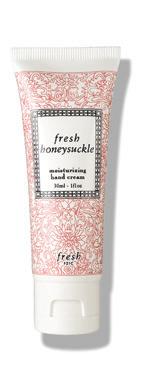
54 — MARYLEBONE JOURNAL / ISSUE NO. 101 A CLOSER LOOK WELLBEING

SUSTAINED IMPROVEMENT
Kerrie Jones, founder of Orri, on how her clinic’s innovative approach to treating eating disorders is achieving remarkable results
Interview:
Viel Richardson
Is there an agreed definition for an eating disorder?
The National Institute of Clinical Excellence (NICE) has clear criteria for determining an eating disorder. The broad principles are an unusually low or high body mass index (BMI) or body weight for age, often with rapid weight loss through dieting or restrictive eating practices. There is also a wider social aspect: things like social withdrawal, particularly from situations involving food. Mental health issues such as a disproportionate concern about weight or body shape tend to be a predominant feature in eating disorders. Then there are the medical issues that can develop, such as menstrual and other endocrine disturbances or unexplained gastrointestinal symptoms.
So, there’s a matrix of symptoms you are looking for.
Exactly. On the physical side, we might see malnutrition, issues with circulation, dizziness, palpitations, there could be abdominal issues, electrolyte imbalances. You can see atypical dental wear if a person has been vomiting a lot. As you can see, there are a whole range of clinical issues. No single patient will exhibit all of them, but looking at this matrix of symptoms can allow us to spot an eating disorder earlier.
You’re a psychotherapist and you work alongside psychiatrists. Can

you clarify the differences between the two fields?
Psychiatrists are medical doctors who have completed a medical degree followed by around five years training to qualify as a psychiatrist. Psychotherapists and psychologists have usually completed six to seven years of university-supervised study and training before going on to a masters or doctorate-level practice. This means that psychiatrists can prescribe medications during the treatment of complex and serious mental illnesses, while psychotherapists and psychologists will provide talk-based therapies in order to treat and support the patient. The crossover comes as both are interested in and understand how the brain works, how our emotions, feelings and thoughts operate. Both can treat mental illnesses using psychological treatments based on talking therapies.
How does the relationship work during treatment?
We treat eating disorders through a bio-psycho-social model. This recognises that there can be a biological component to eating disorders. We see it often enough, particularly in anorexia, to recognise that there can be hereditary factors. With eating disorders, the physiological and the psychological are intimately intertwined, with physical problems often needing to be treated alongside the psychological ones. This
56 — MARYLEBONE JOURNAL / ISSUE NO. 101 A CLOSER LOOK HEALTHCARE
makes the relationship between the psychiatrist and the psychotherapist vital. When working with complex eating disorders, a psychiatrist needs to have oversight of the patient from a physical health presentation. We might be monitoring their bloods, ECGs and other clinical observations. Together we assess the patient’s overall physical and psychological health before discussing what may be needed next. Often there are cooccurring conditions such as anxieties, depressions, trauma, emotionally unstable personality disorder or neurodivergent complexities. These can all have clinical manifestations, so close communication between the psychotherapist and psychiatrist is vital.
How do you approach medication when it’s needed?
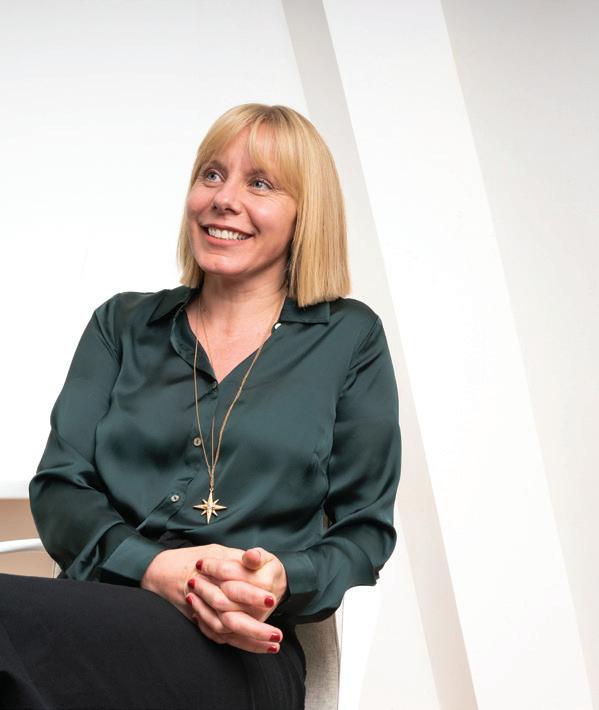
The psychiatrist will be taking the lead here. They will take a very detailed history and we’ll discuss the patient’s presentation before they decide to prescribe a medication. For example, bulimic patients really struggle to manage their impulsivity around purging and there are certain medications that are shown to be very helpful in managing that. Some clients struggle with depressive issues and they may need medication to support them in managing that depression. However, the first medication needed is often food. In patients with very low weight, we need to settle the body through nutrition to get it functioning properly. When you do this, a lot of the mood stabilisation can occur relatively naturally. But when medication is needed, the psychiatrist will very much take the lead in terms of prescribing and managing the process.
As the relationship with food is clearly fractured. How do you navigate the reset?
This is a complex process because it’s not simply about what you eat, when you eat and how you eat. We do a lot of work around what we call ‘symptom interruption’: breaking the chain of behaviour the condition >
57 — MARYLEBONE JOURNAL / ISSUE NO. 101 A CLOSER LOOK HEALTHCARE
causes. This means really looking into the structure of their relationship with food. You need to understand what isn’t there that would allow them to have a healthy relationship with food before you can begin the work of resetting that relationship. This will be different for a patient with dietary restriction to someone dealing with bingeing and purging. You also really need to understand what the body is missing and how best to introduce it. Re-introducing food too quickly can be extremely dangerous, especially in cases of starvation. We have trained dietitians who provide practical clinical support like creating nutritional menu plans for each individual. But it’s not just menu planning, it’s also providing psychological support and reassurance. They are a key part of understanding the relationship between food and the individual. For example, in cases where people have suffered significant trauma, food can be closely attached to that experience, through texture, smell or sensation. Understanding and taking account of this can be key to a patient’s recovery.
You operate a day-care model. Why go down that route?
I worked in inpatient care for a several years and I’m a huge advocate for it when needed. There are times when the individual needs respite from their usual environment and the family needs respite from their suffering. It’s an immensely stressful experience to have an eating disorder in the family. Sometimes a patient becomes dangerously physically compromised or so psychologically damaged that we turn to the Mental Health Act to get them into the place of recovery they desperately need. However, I saw too many people stuck in longterm inpatient placements because there was nowhere for them to go. Or patients who having been discharged had found themselves with no support structures in the community and ended up in hospital again. I thought there must a better way to help these patients. There is not a widespread
culture of daycare treatment for eating disorders in this country and I wanted to develop a daycare system that I believed could be effective.
What does your system look like?
We have what we call a step-down model. Clients might start by coming to the facility five days a week. Then the time they spend with us decreases as treatment progresses, and by the end they’re doing half a day a week online. The key is that they never lose that integration with their everyday life. Because they go back to their home environment each night, they come in saying “this went brilliantly” or “that was a nightmare”. This allows us to home in on what we need to be working on. It’s really powerful, and it really works.
The learning comes through the outcomes achieved with our clients. We look at things like the Eating Disorder Examination questionnaire and Depression, Anxiety and Stress scale. We look at other markers like motivation, emotionally unstable personality disorder and autism. The aim is to increase our understanding of the psychological aspects of both the illnesses and effective treatments.
How successful has it been?
Is there such a thing as
an average recovery time?
We don’t impose arbitrary time constraints on treatments. Our average length of treatment is around 24 weeks but that varies widely. If you come with a BMI of 14 as opposed to one of 18 it will take longer to recover the weight. Six to 12 months in outpatients is not uncommon. This flexibility is key. If a patient is on a 12 or 24-week programme and feels they’re falling behind, it is easy for them to succumb to thoughts of “I’m unfixable, I’m unreachable, I’m the problem”. Removing a timeframe relieves that pressure. It can take between five and eight years to fully recover from an eating disorder, which is a pretty tough number to hear. But the person won’t be living with the same level of illness for all that time. Things will get better and life will improve.
Orri has a director of research and development. What does he do?
Professor Paul Robinson concentrates on improving our understanding of eating disorders. There’s still so much we just don’t understand. We really wanted to invest in research and development of ideas for the broader community. We have three pillars at Orri; we treat, we learn and we teach.
Broadly speaking, around 46 per cent of people treated for anorexia will recover fully while between 20 and 33 per cent remain chronically unwell. We’re very proud that at Orri we have a 78-80 per cent recovery rate, significantly above average. There are many reasons for this, one being our model of treatment that – while offered by some NHS trusts – isn’t widely accessible. Recovery is not easy and there will be relapses, but I always tell patients that these are a real source of strength for their long-term recovery because you can learn so much from them. It feels very painful for the individual but it is not time wasted.
Can you ever fully recover?
Absolutely. I have seen desperately ill people in the most unpromising of situations fully recover. I have an office full of cards, pictures and letters about weddings, graduations, babies, people at the top of mountains. Some people will always need to be more attentive if they find themselves in emotionally difficult territory. But this will be the exception, not the norm. Severe eating disorders isolate people by stripping away their trust in others, and with it, their ability to ask for help. True recovery re-connects people with their loved ones, it gives them the ability to trust again. Mostly it gives them the confidence that when life throws up challenges they will have the resilience and support network to get through them successfully.
ORRI
80-81 Wimpole Street, W1G 9RE
orri-uk.com
58 — MARYLEBONE JOURNAL / ISSUE NO. 101 A CLOSER LOOK HEALTHCARE
Don’t ignore the symptoms of Prostate Cancer
If you’re experiencing issues commonly associated with prostate cancer or an enlarged prostate such as the urge to urinate more often & during the night, a weak flow or urine that takes a long time to come out or blood in the urine, now is the time to speak to an expert urologist.
King Edward VII’s Hospital has world-leading experts in prostate cancer and prostate enlargement and offer a range of cutting edge treatments including Focal Therapy, which has a lower risk of incontinence and erectile dysfunction with rapid recovery times.


Experts in Men’s Health
Our multi-disciplined teams include world-leading experts and clinicians in:


• Urology • Prostate Cancer • Andrology
• Digestive Health
• Pelvic Floor Health
Caring for our Armed Forces since 1899

Rated Excellent on Doctify 4.83 out of 5 based on 2821 patient reviews Find out more at kingedwardvii.co.uk or call
friendly
our
team on 0203 991 1182
King Edward VII’s Hospital Centre for Veterans’ Health offers grants, discounts and free programmes for UK veterans.
MY PERFECT DAY
Tracey Neuls, founder of
the eponymous shoe brand, on her perfect Marylebone day
Interview: Clare Finney
Images: Eleonora Boscarelli, Orlando Gili
Breakfast
In the morning, I’m more of a coffee person than a big sit-down person. Ottolenghi is sublime for grabbing something on the go, from granola to fruit tarts – he does seeds and nuts so well. The coffee there is strong – never too much milk – which is just the way I like my coffee.
A breath of fresh air
My daughter went to a local Montessori school some years ago and the walk from my shop through the local Paddington Street Gardens was the best part of the journey. You pop out of a bustling high street into this hidden breath of fresh air. There is something very serene about it, despite it being welcoming to children and dogs, which I adore. Parks are for everyone, and this little gem is the perfect spot to take 10 minutes out in your day and listen to the birds.
A new outfit
There is nothing better than a vintage find to bring an outfit together around a
new pair of shoes. There are several vintage or charity retailers in Marylebone and it’s a quick walk to visit them all. From Bernardo’s to Cancer Research to Oxfam, I love the hunt for that timeless piece that really makes an outfit special.
Shopping
The architecture of Marylebone is low level, with shop fronts barely changed or modernised. You can stroll down Marylebone Lane to Chiltern Street to the calm high street and whatever turn you take, there is always a lovely shop to browse in. For me, shopping is about the unknown, the surprise –and there are a lot of ‘finds’ to be had in Marylebone.
Culture
The culture in Marylebone is one of contentment and confidence – the village seems to be ‘well in itself’. There is no need to show off or prove anything to anyone. For me, Marylebone is special for all the labels it doesn’t carry. Perhaps its barely detectable humble beginnings account for this attitude of openmindedness. From the art at the Wallace Collection to independent galleries like Mint to classic pubs to foodie events to independent local shops, it’s a small town in a big city.
Pre-dinner drink
I wouldn’t say no to a Gibson martini served sitting on a stool at a long bar, which is why The Ivy Café is perfect. Chatting with the barperson,
watching them shake a cocktail – it’s all part of the fun. I do also love a good glass of wine. Le Vieux Comptoir is local, yet truly French. It’s tucked away on a side street, which adds to its charm.
Dinner out
KOL is just exceptional. I adore Mexican food, but KOL is on another level. You will enjoy everything on offer from the attentive staff to the salt dispenser and of course the food – it really is amazingly good! Even if you manage to just pop into its downstairs bar, you’re still in for a treat. Sip inventive margaritas – and you must try their pistachio guacamole. What a revelation this whole venue is.
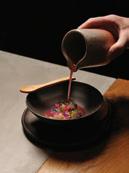
Dinner in
There are so many places in Marylebone where you can casually go without the need to get dressed up, so in some ways it’s just easier and quicker to eat out. However, La Fromagerie ticks all the boxes – a place to be inspired while shopping, a place to buy ingredients for cooking at home, or a simple cheese and fruit plate. Or you can just eat in for an early dinner!
Anything else
Marylebone is a one-stop shop. Meeting friends here is more than a day out. It is still one of my favourite parts of London – steadfastly timeless and unique at the same time.
TRACEY NEULS
74-78 Marylebone Lane, W1U 2PW traceyneuls.com
60 — MARYLEBONE JOURNAL / ISSUE NO. 101 A CLOSER LOOK MY PERFECT DAY
Le Vieux Comptoir
Opposite: KOL

61 — MARYLEBONE JOURNAL / ISSUE NO. 101 A CLOSER LOOK MY PERFECT DAY
W1H 5QL
George Street, Marylebone, W1H
Guide Price: £3,350,000
A modern family home within a secure 24 hour portered block close to Marble Arch and Hyde Park.


Jaffray Estates are proud to present for sale this spacious apartment situated on an upper floor in this popular purpose-built block. The property boasts a large reception room, a separate kitchen with adjoining maid’s room and shower room, and then there are four good sized bedrooms (all with air conditioning), three bath/shower rooms and a guest cloakroom.
Leasehold: 127 years

Wigmore Mansions, Wigmore Street, W1U
Guide Price: £2,750,000 Off Market
An exceptional apartment on the first floor, with floor to ceiling windows, located close to Bond Street, sold to a cash buyer though our network.
Fifteen Portman Square, Marylebone, W1H
Guide Price: £1,895,000 Sole Agent
We are pleased to announce the sale of this beautiful two bedroom apartment with multiple interested parties, selling in excess of the guide price to a cash buyer.
Fifteen Portman Square, Marylebone, W1H


Guide Price: £2,850,000 Sole Agent

We are thrilled to confirm the sale of this three bedroom flat facing the gardens in Portman Square, sold to one of our international buyers.

If you are looking to buy or sell and would like advice on the current market or a free market appraisal contact:
Nicholas Jaffray
07515 777 634
Nicholas@Jaffray-Estates.co.uk
www.Jaffray-Estates.co.uk
London
42 Upper Berkeley Street
JULY JUSTSOLD JULY JUSTSOLD AUGUST JUSTSOLD
MONTAGU SQUARE, MARYLEBONE W1

sales@mcglashans.co.uk
lettings@mcglashans.co.uk


£1,950,000 STC
An elegant ground floor maisonette with beautiful high ceilings overlooking this prestigious garden square. Drawing room, dining room, kitchen, 2 bedrooms, 2 bathrooms (one en suite), utility room with wc, private garden square (fees apply). EPC Rating – D, Council Tax (Westminster) – Band G, Service Charge –£627.73 per quarter, Ground Rent – £500pa, Leasehold – 85 years less 3 days from 25th December 1991.


EXECUTIVE PROPERTY SPECIALISTS
020 7486 6711
107 CRAWFORD STREET, LONDON W1H 2JA WWW.MCGLASHANS.CO.UK For tenancy Info please refer to the website






RECENT SALES MARYLEBONE PROPERTY AGENCY ESTABLISHED 1981 jeremyjames@jeremy-james.co.uk 020 7486 4111 www.@jeremy-james.co.uk MARYLEBONE PROPERTY AGENCY ESTABLISHED 1981 jeremyjames@jeremy-james.co.uk 020 7486 4111 www.jeremy-james.co.uk
Mansfield Street
Marylebone W1G
A well-proportioned 2-bedroom, 2-bathroom apartment in this popular portered mansion block.
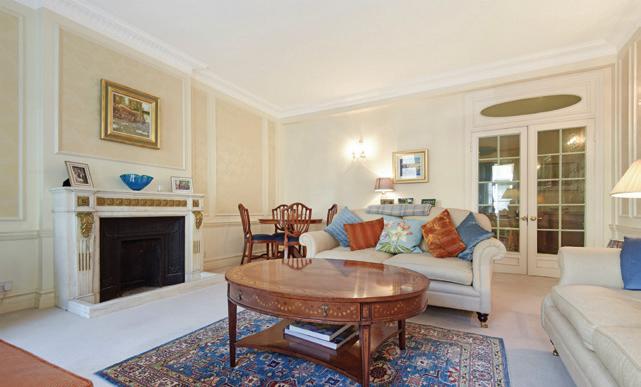

2 double bedrooms • 2 bathrooms • Portered mansion block • Excellent condition • Approx 1000 sq ft •
Share of freehold • Raised ground floor • Incredible central location
Guide price: £1,625,000


Marylebone & Regent’s Park 020 7299 2447
robert.oatley@carterjonas.co.uk











































































































































